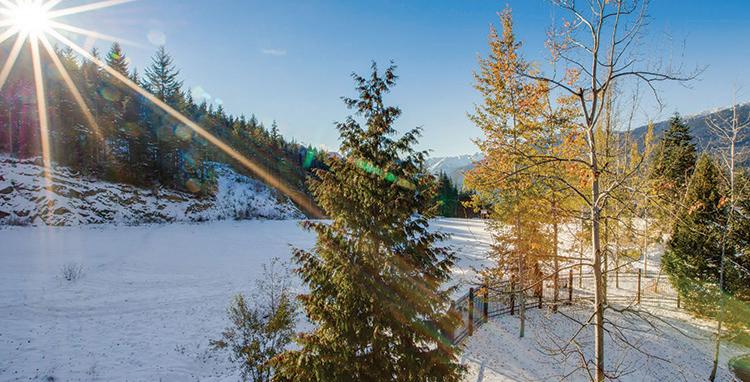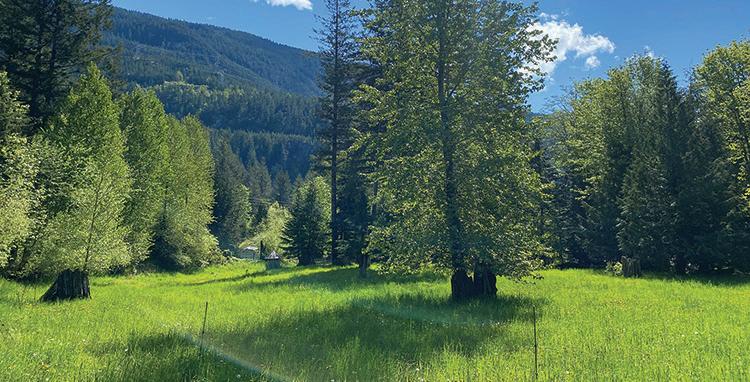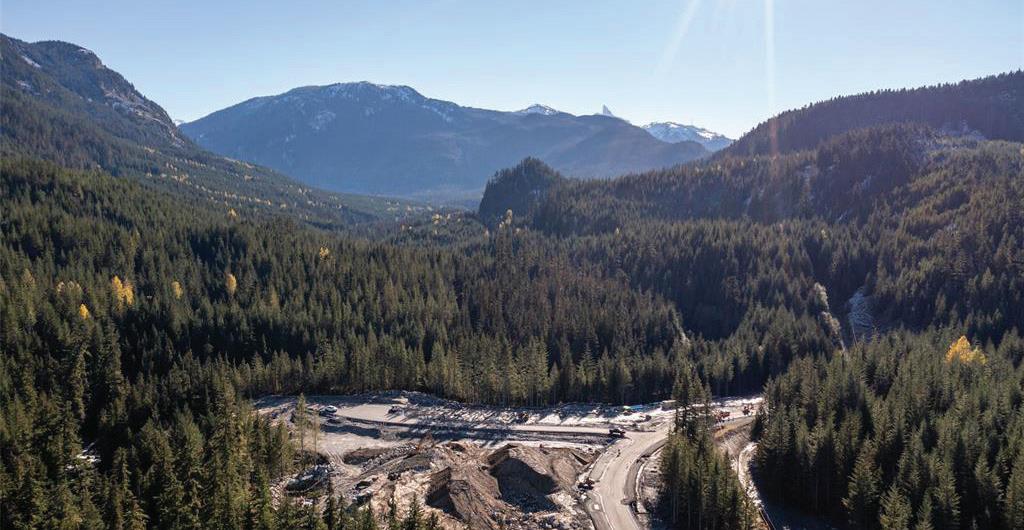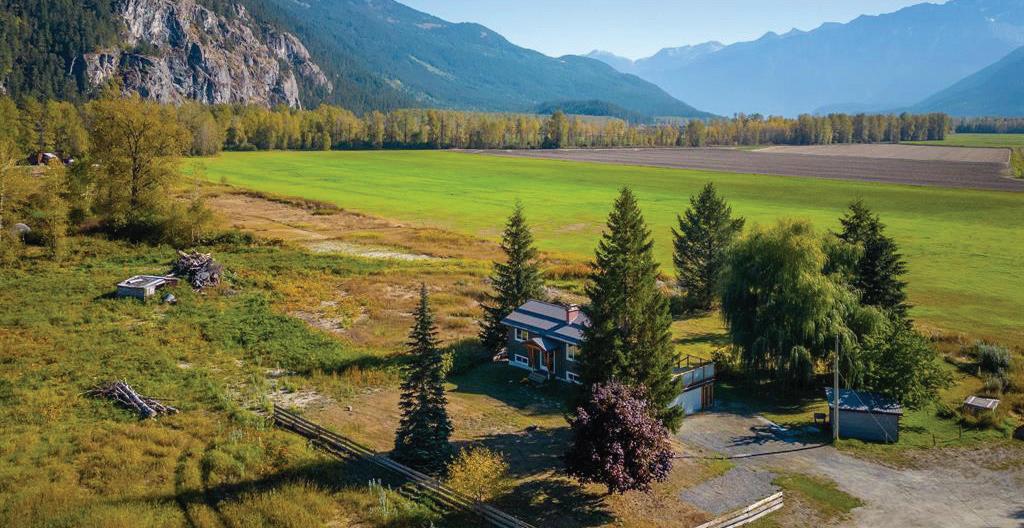
















































































































































































14
The Resort Municipality of Whistler is proposing an 8.3-per-cent tax increase in 2023.
The Whistler Blackcomb Foun dation’s Founders Pass program is doubling in size—and doling out $500,000 to health-care in Whistler.
Whistler’s immigrant commu nity now makes up a quarter of the population—but is the resort primed to welcome the influx of newcomers?
24
Pemberton teen Lennox Davies recounts the day he saved his best friend’s life.
The Whistler Skating Club is gear ing up for its biggest fundraiser of the year on Dec. 9.

Whistler children’s performer Ira Pettle fulfils a lifelong dream with his debut album, A Little Bit

An account of last year’s devastating flooding of the Nicola River. - By J.B. MacKinnon / Hakai Institute COVER Minus all the natural disasters, the Nicola Valley looks like a wonderful place to live. No shortage of helping hands and friendly faces. - By Jon Parris // @jon.parris.art





























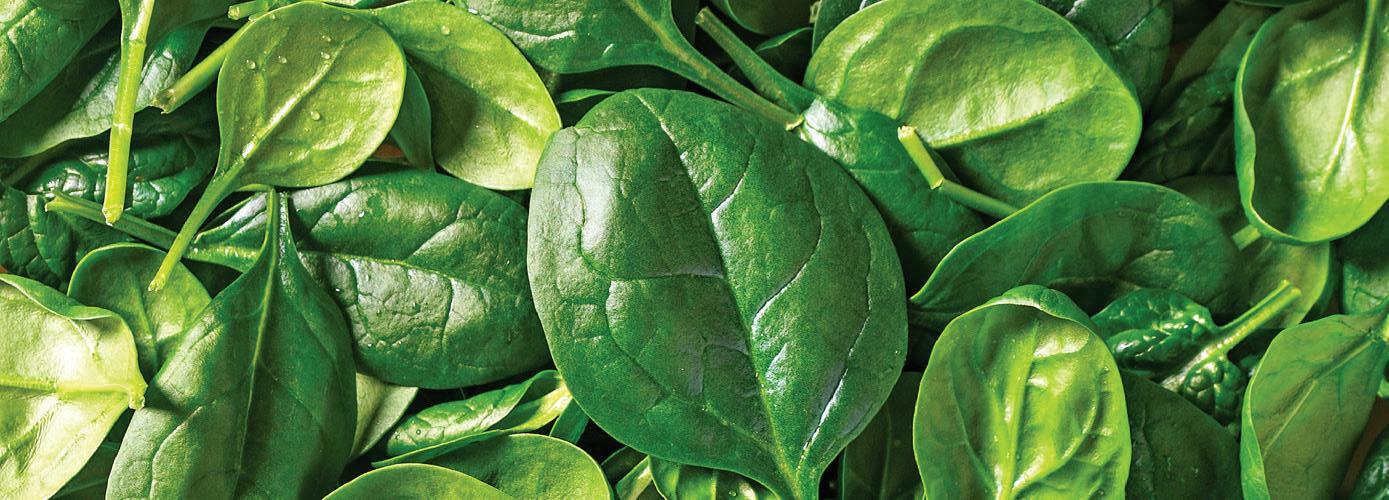


















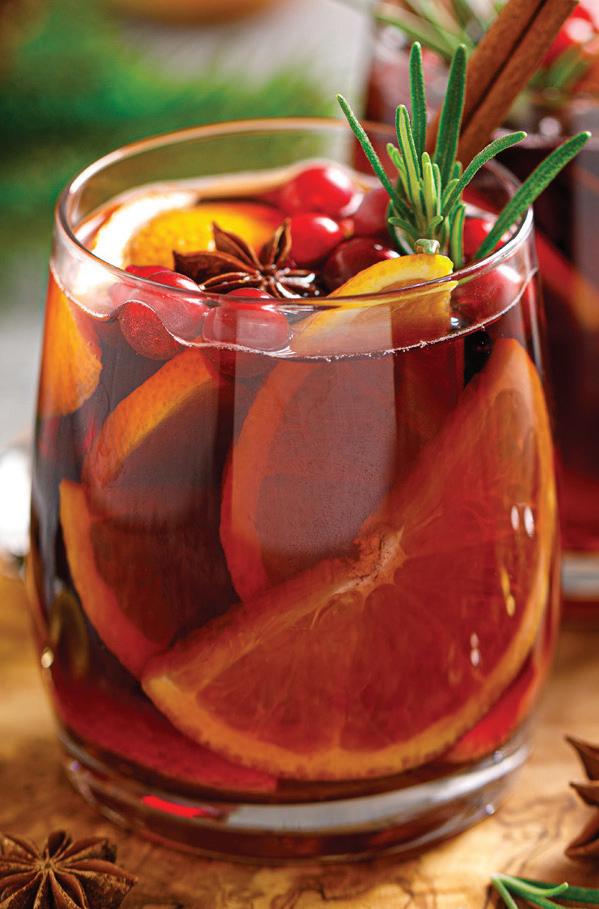










































Founding Publishers KATHY & BOB BARNETT
Publisher SARAH STROTHER - sstrother@wplpmedia.com
Editor BRADEN DUPUIS - bdupuis@piquenewsmagazine.com
Sales Manager SUSAN HUTCHINSON - shutchinson@wplpmedia.com
Production Manager AMIR SHAHRESTANI - ashahrestani@wplpmedia.com
Art Director JON PARRIS - jparris@wplpmedia.com
TESSA SWEENEY - tsweeney@wplpmedia.com
GEORGIA BUTLER - gbutler@wplpmedia.com
Digital/Sales Coordinator AMELA DIZDARIC - traffic@wplpmedia.com
Production production@piquenewsmagazine.com
Features Editor BRANDON BARRETT - bbarrett@piquenewsmagazine.com
Arts Editor ALYSSA NOEL - arts@piquenewsmagazine.com
Social Media Editor MEGAN LALONDE - mlalonde@piquenewsmagazine.com

BRANDON BARRETT - bbarrett@piquenewsmagazine.com
MEGAN LALONDE - mlalonde@piquenewsmagazine.com
ALYSSA NOEL arts@piquenewsmagazine.com
ROBERT WISLA - rwisla@piquenewsmagazine.com
DAVID SONG - dsong@piquenewsmagazine.com
Classifieds and Reception mail@piquenewsmagazine.com
Office and Accounts Manager HEIDI RODE hrode@wplpmedia.com
Contributors G.D. MAXWELL, GLENDA BARTOSH, FEET BANKS, LESLIE ANTHONY, ANDREW MITCHELL, ALISON TAYLOR, VINCE SHULEY, LISA RICHARDSON
President, Whistler Publishing LP

SARAH STROTHER - sstrother@wplpmedia.com





















IT’S THE MOST wonderful time of the year! Whistler budget season, that is.
If you’ve avoided the news to this point, here’s the big takeaway: the Resort Municipality of Whistler (RMOW) is proposing an 8.3-per-cent tax increase in 2023—the largest we’ve seen in years.
RMOW officials are well aware of how the community will react to this, judging from how they tried (unsuccessfully) to both spin and bury the real headline in their Nov. 29 press release.
BY BRADEN DUPUIS“Whistler proposes tax increase half a per cent above inflation” the headline read. The actual tax increase wasn’t mentioned until the fourth paragraph, where it was sandwiched between an explanation that the large increase is necessary to maintain existing service levels, and reminders that Whistler’s 2022 residential municipal mill rate—the amount of tax payable per dollar of assessed property value—was the lowest in British Columbia in 2022, and that the municipality has had lower-than-average tax rate increases for the last decade.



That may be true, but does it mean anything to financially strained local taxpayers and business owners?
The press release also neglected to mention the RMOW’s proposed utility tax increases for 2023: three per cent for water,
four per cent for solid waste, and five per cent for sewer fees.
The utility-fee bumps would amount to increases of $13, $14, and $15 respectively. An 8.3-per-cent tax increase will work out to about an extra $100 on a home assessed at $1 million; $387 for a home assessed at $4 million.
(Those living in Whistler Housing Authority units will likely see much lower increases, and as always, your individual tax bill will vary based on the value of your home and fees levied by other authorities).

now when your tax bill shows up asking for hundreds of dollars more than last year.
As the RMOW inferred in its carefullyworded, pre-budget press release, it should be noted that inflation is wreaking havoc on budgets big and small this year, so it would almost be more surprising if Whistler avoided the impacts entirely.
It’s also encouraging to read that staff are proposing six-per-cent less project work in 2023 and a review of staff compensation (including benchmarking against comparable
projects worth an estimated $38.3 million (about $8.6 million of which is carried over from 2022)—that’s down from $45.7 million in last year’s budget, and the $54.9 million budgeted for projects in 2020 (though that spend was inflated by a $10-million loan to the Whistler 2020 Development Corp for construction of affordable housing).
Outside of necessary investments in park and sewer infrastructure, this year’s project list is lacking in the big-ticket spends seen in previous budget. So at first glance, at least, the
That a government would try to spin, deflect, or lessen the blow of bad news is not exactly surprising—but it would still be nice if officials (of all stripes, not just at the RMOW) would just be straightforward with their information and respect the public’s intelligence. I’m not going to hold my breath for that particular Christmas miracle.
However the RMOW wants to frame it, the fact remains that Whistlerites are looking at an 8.3-per-cent tax increase in 2023.
If that doesn’t sit right with you, now is the time to speak up—not six months from
communities) in light of inflation and the ongoing labour shortage.
“Our operations are pressured by supply chain delays and labour challenges, so we need to attract and retain talent,” Mayor Jack Crompton said in the release. “Our people are the ones who do the legwork to tap broader funding sources, advance critical infrastructure upgrades, meet budgets and deliver municipal services. It’s very important we remain competitive in this labour market.”
The 2023 budget counts more than 350
project cuts pass the eye test.




But an 8.3-per-cent tax increase is tough to swallow any way you slice it.
Whistler’s budget guidelines will be back before council on Dec. 20, with first readings of the five-year financial plan bylaw scheduled for Jan. 10.

Head to whistler.ca/budget to review the budget materials for yourself, and be sure to submit your feedback to mayor and council in any way you can—I hear they like it when people show up in person at meetings to ask questions at the podium. ■

would try to spin, deflect, or lessen the blow of bad news is not exactly surprising— but it would still be nice if officials ... would just be straightforward with their information and respect the public’s intelligence.
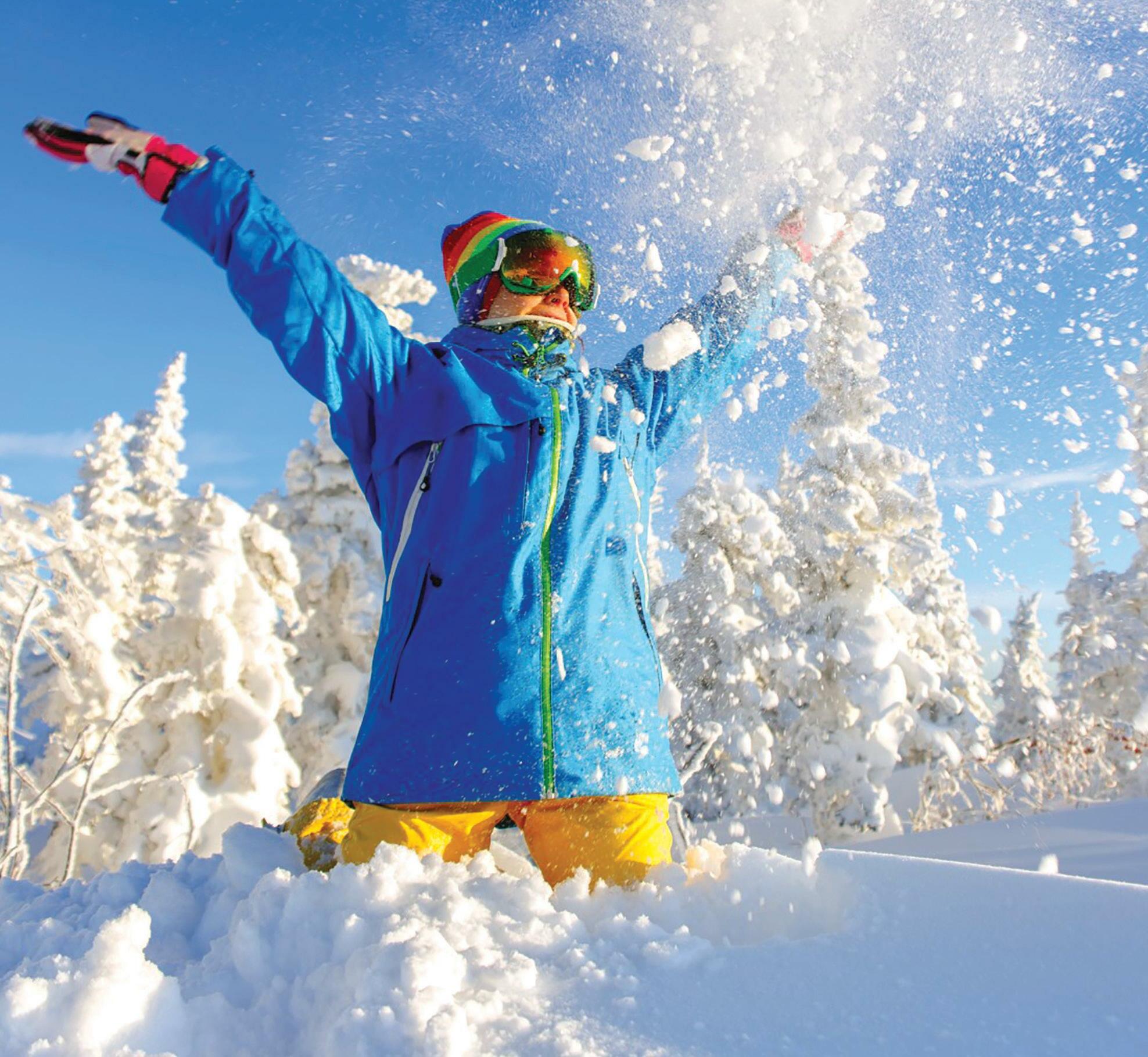


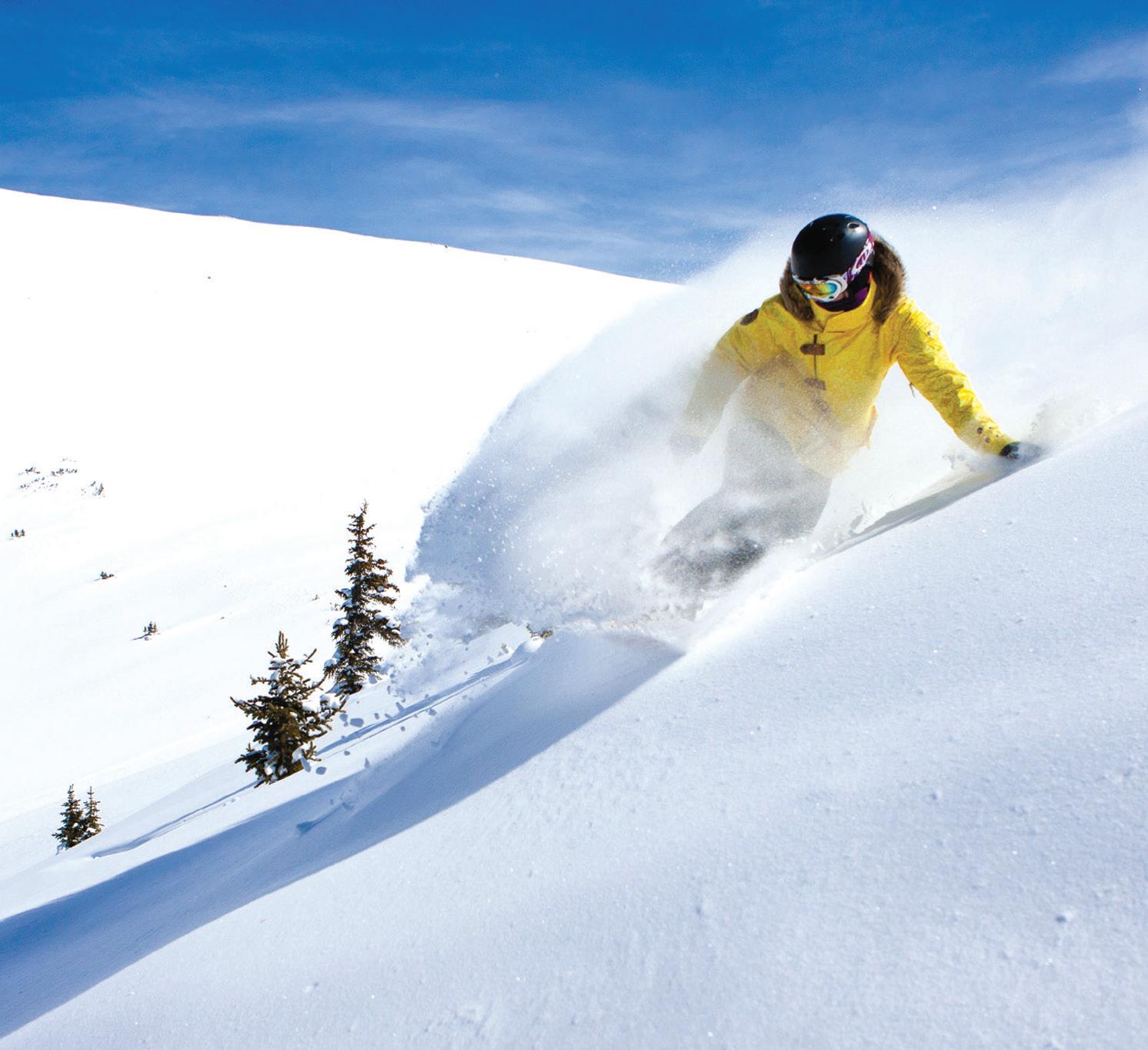


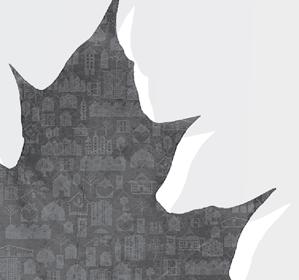










I can’t imagine Pique has not leaned hard into the subject of an unaffordable Whistler in recent years, but it may be time to consider some talk and solutions to the Whistler tragedy that currently is the high cost of long-term and seasonal accommodation living. Add in the higher cost of groceries and today’s fuel prices and you truly want to cry. It pains me, knowing the history of Whistler first-hand, to compare how it once was and how it is today!
When I was in my teens, I skied here in Whistler most weekends along with the rest of my family and many others from Vancouver. My parents were by no means extremely wealthy, but loved skiing Whistler and wanted to share that family activity with their kids and grandchildren over the years. So many great memories are based here, and we all worked hard and earned our days here over the years to make that a possibility. Back then, the valley was often filled with smiling faces and jovial laughter as the layers of winter would build up week after week and mountain slopes were carved up by friends and others, largely Vancouver skiers that supported Whistler Mountain ski operations.
The cost of doing so back then was reasonable. About $250 for a season pass for youth, as I recall on Whistler, and the cost of owning a cabin or weekend chalet was then not out of this world—$49,000 is what my parents spent to purchase a new Alpine Meadows chalet in Whistler back in the day. Fast-forward 50 years and that same chalet could now cost $4.9 million. Wages have definitely not gone up 100 times since back in the day, so how are people to make ends meet here and now?
One sees the world around them all differently as we grow older based on our own life experiences. I think the accommodation rental and cost crisis that is unfolding in Whistler is potentially going to destroy the
valley’s great 55-year ski journey. I say that because you cannot treat young adults that are here to do the front-end service work like farmed chickens. Packing them into old accommodations and charging them more than $1,000 per head is simply stealing away their money and youthful happiness. It is fundamentally wrong. If you are going to do that as landlords, then Whistler’s employers will suffer, and so will the whole valley. The cost of food here in grocery stores is equally pocket-draining, and at the end of the day, if you can do some simple math, you should know [why] … the joie de vivre that once defined the valley vibe has vanished! If Whistler truly wants that back, it will need to look in the mirror and ask itself what it wants to be known
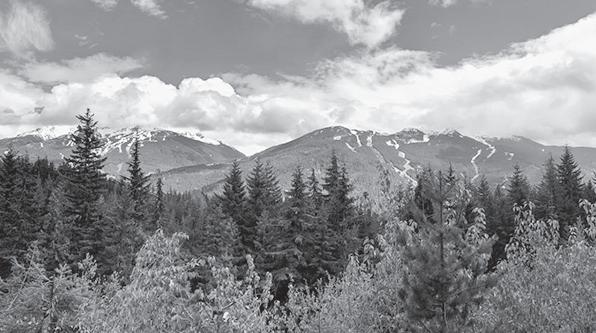
for the world over. The answer, in my opinion, is to be more generous in ensuring a high quality of living, and less demanding on people’s pocketbooks.

If I was Mayor “Happy Jack” Crompton of Whistler, I would be immediately encouraging local grocery stores to offer up our local Whistler workforce 30 per cent off on all groceries on Sundays and Thursdays after 5 p.m. Make it mandatory that there is a real bed for each individual adult or couple within any rental property, and that those properties meet a minimum standard as a requirement to be rented to protect the integrity of Whistler as a destination resort and as a respected community. Couch surfing, closet living or being camped out and freezing in a vehicle in Whistler is just not right. Whistler must change this for the better! In addition, encourage Whistler Blackcomb and Vail Resorts to offer all locals, meaning those currently living/working here for five years or more, and those that have been a founding economic force in the evolution of Whistler since its very beginnings (our many lifetime Vancouver skiers), a Whistler


Blackcomb Golden Ski Pass—10 ski days per season for $600. Please also build more Whistler Housing Authority affordable housing developments for local workers, and watch the joie de vivre return to this great valley once again.



I know I may be late to the table on this, but felt that I should add my two cents on the Sea to Sky Trail link to Nairn Falls (“SLRD sticking to original plan in Sea to Sky Trail expansion to Pemberton,” Pique, Nov. 7). I must have missed the engagement.
After riding the trail route from Squamish to Pemberton through the decades, I feel it is important to keep the experience as remote and engaging as possible. The proposed route that runs along the west side of Highway 99, is not, in my mind, appealing to the recreational user.
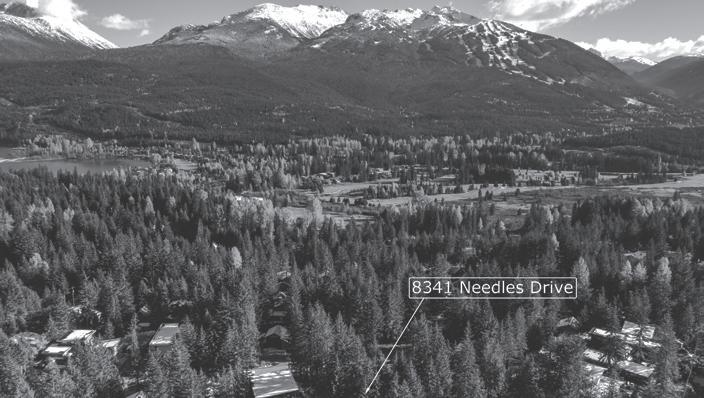
The interface with Highway 99 and the railway, as well as a compost facility, storage yard and gun range, is littered with visual, odorous and noisy highlights.



Although the alternate route on the east side of the Soo/Green rivers would be more costly and more difficult to build with the bridge needed to connect, the long-term vision and natural beauty of the experience would be appreciated and utilized more.
So I encourage a revisiting of this decision on the routing of the Sea to Sky Trail to reconsider and create something special like the Gordon’s Garden section. I think he might have wanted it that way.
I would also be able to help raise some additional funds to make this happen. Got skin in the game.
Grant Lamont // Whistler



Myrtle Philip Community School is celebrating its 30th birthday this year. It was brought to the attention of the Parent Advisory Committee (PAC), by our principal Mrs. Katrina Lowe, the need for new technology in the classrooms.
So the PAC got to work. A fall fundraiser was set to ask parents and guardians to help by donating $30 per student, with a goal of raising $9,000. The class that raised the most will receive a pizza party.
We passed the goal and raised $11,025. This large sum will help us with purchasing iPads and cases for a full class of 30 students.
We would like to thank the parents and guardians for your donations. We would also like to thank three members of the Old School Initiative, Beau Jarvis from JBJ Investments, Curtis Neeser from Beedie Development Group and Matt Woods from Coastal Mountain Excavations for their generous investments to the cause. The Touchet family also saw the value in donating to the cause that will help current and future students at Myrtle Philip. Thank you to the dance company, Dancepl3y, which donated proceeds from a dance to the fundraiser.
The class that raised the most and earned the pizza party was Ms. Ireland’s Grade 2/3 class. Congratulations!
Jodi Carter / on behalf of the Myrtle Philip Community School PAC ■



AS OF WEDNESDAY, DEC. 7
The recent stormy conditions brought new, and much needed, snow to the region. While this new snow will certainly bring improved riding conditions, we are concerned that it may not bond to an old snow surface that has been weakened by the extended period of cold and dry weather.
Fresh snow always takes time to stabilize after a storm. This time we’re not just waiting for the fresh snow to stabilize. Down 60 to 80 centimetres below the surface in the snowpack is an older melt-freeze crust. There’s also a crust with facets above it. This layer hasn’t been super active lately, but with Thursday’s storm it could reawaken.
With the potential for active weak layers this weekend, one of which is deep but still within range of triggering, a conservative mindset could serve you well. It’s not a typical snowpack, so it’s important for people to adjust expectations and treat the snowpack with a bit more respect.
A persistent slab avalanche problem can catch backcountry recreationists by surprise, because the hazard is not always obvious. Select more conservative terrain and practise good travel techniques, like not having your whole group on a slope and planning your escape route.
Remember to verify conditions by watching for signs of instability. Two important signs are:


Recent avalanche activity.
The sound of the snow collapsing beneath you (i.e., “whumpfs”) or shooting cracks that appear in the snow from under your equipment or feet.

These signs indicate the snowpack structure is primed for human-triggering, meaning the weight of a person or machine moving over the snow could be sufficient to release an avalanche. The safest course of action is to back off to safer terrain.
As always, be sure to track the forecasts and advice at avalanche.ca to get the most up-to-date information before heading out for the weekend. ■
Write to us! Letters to the editor must contain the writer’s name, address and a daytime telephone number. Maximum length is 450 words. Pique Newsmagazine reserves the right to edit, condense or refrain from publishing any contribution. Letters re ect the opinion of the writer and not that of Pique Newsmagazine GOT GOOD VIBES TO SHARE? Send them to goodnews@piquenewsmagazine.com

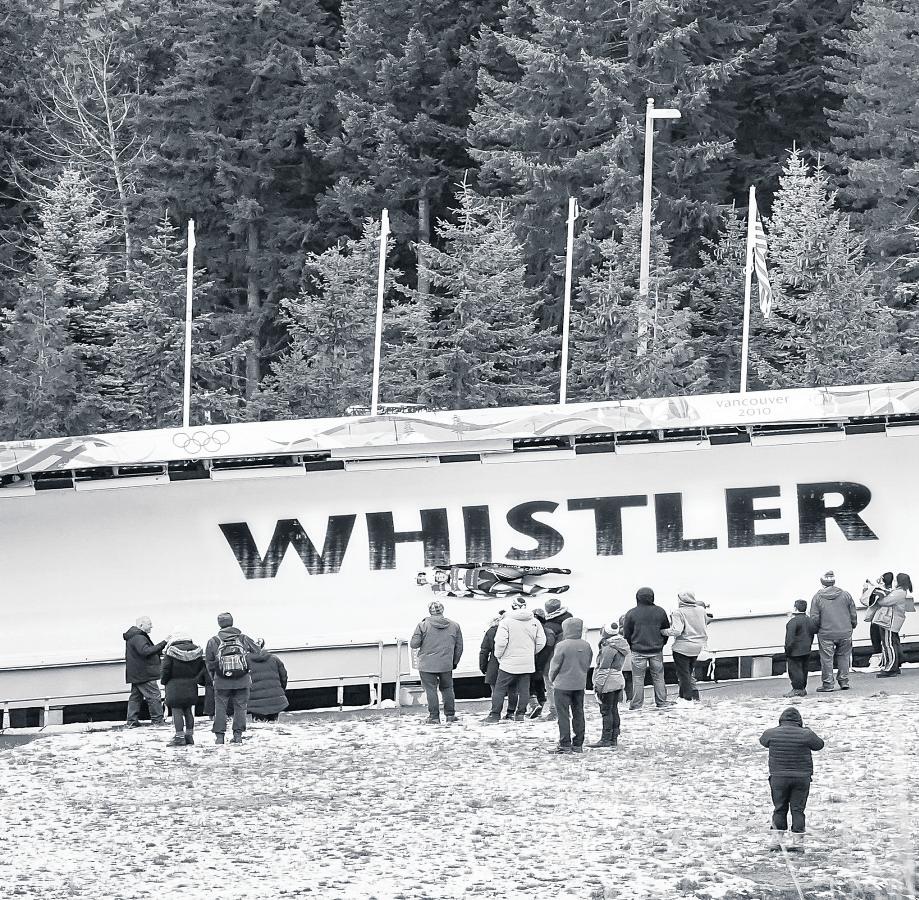





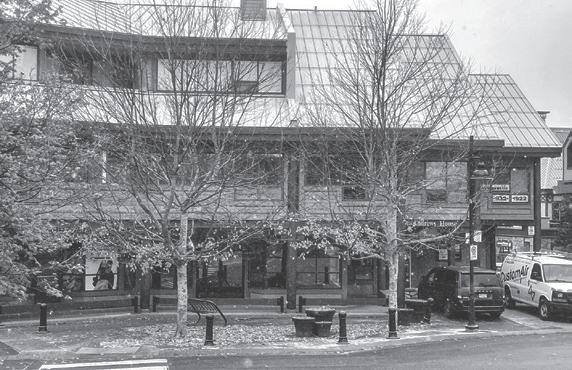



IN CASE YOU missed it, Kanye West was banned from Twitter last week. Again.
The final straw this time was an image posted by the rapper, who now goes by Ye, of a swastika surrounded by the Star of David.
He was previously banned from Twitter in October, after unleashing a series of antisemitic tweets, including one in which he threatened to
BY MEGAN LALONDE“go death con 3 on Jewish people,” a few weeks after displaying a “White Lives Matter” shirt at a Paris Fashion Week event. It was the latest and wildest plot twist after years of increasingly inexcusable behaviour from someone who has (had?) tens of millions of followers.
Still, those revolting words and actions on their own weren’t enough to convince Twitter’s new owner that maybe it might be a bad idea to continue giving the man a public platform. Magnate Elon Musk officially bought the social media platform at the end of October, turning the formerly public company private in a $44-billion deal motivated, at least in part, by Musk’s concerns about Twitter’s moderation policies and their effect on “free speech” and democracy. Or at least the definition of free speech he subscribes to.
To that end, among Musk’s first priorities following the takeover were reinstating several individuals barred by Twitter’s former management, like West, and President Donald Trump, who earned himself a permanent ban for tweets that incited violence during the Jan. 6 Capitol riots.
(Just to prove his point, West doubled down on his most recent exile from Twitter with an appearance on InfoWars—that’s the one hosted by that guy who claimed the Sandy Hook shooting was a hoax—alongside a Holocaust denier, where West stated several inconceivable sentences I don’t feel like I need to repeat here. Let’s just say the show’s absolutely deranged conspiracy-theorist host came out looking like the reasonable one.)
Since Musk’s takeover, more than half of Twitter’s staff have been fired or resigned, and its advertisers are reportedly dropping. Musk ended the enforcement of a policy aimed at curbing COVID misinformation. Not surprisingly, the amount of hate speech on the platform is on the rise.
According to a Dec. 2 report from the New York Times, “slurs against Black Americans showed up on the social media service an average of 1,282 times a day,” before Musk took over Twitter. “After the billionaire became Twitter’s owner, they jumped to 3,876 times a day.”
Meanwhile, slurs targeted towards gay men popped up 2,506 times a day, on average, rising to 3,964 times a day after the takeover,
while “antisemitic posts referring to Jews or Judaism soared more than 61 per cent in the two weeks after Mr. Musk acquired the site.”
The findings came from the Center for Countering Digital Hate, the AntiDefamation League and other groups that study online platforms, according to the Times . The report found Twitter accounts associated with groups like the Islamic State and QAnon have also seen a resurgence since Musk’s deal was finalized.
I remember when I first created a Twitter account. I was in Grade 11, at school working on a project. One of my classmates was trying to win a contest to meet Justin Bieber, or something.

I didn’t fully grasp the idea of Twitter. Was it just to send messages to your favourite celebrities? To update the friends who didn’t have BlackBerry Messenger about your current emotional status or plan for the day? (I don’t think my friend won the contest, for the record.)

But not even Twitter’s creators had a super-clear idea of what they were building, at the time. “Twitter actually changed from what we thought it was in the beginning,” co-founder Evan Williams explained in 2013, “which we described as status updates and a social utility. It is that, in part, but the insight we eventually came to was Twitter was really more of an information network than it is a social network.”
Twitter’s superpower became updating


a large group of people with need-to-know information, often immediately. Like in the event of a public emergency, for example.
Otherwise, it kind of sucks.

For years, I’ve avoided it as much as someone with the words “Social Media Editor” in their job title can, using Twitter only sporadically, almost exclusively for professional purposes. I don’t think that’s going to change anytime soon.

It’s the platform that invites the snarkiest of internet users to be their snarkiest selves. That snarky-ness can breed some truly topnotch humour, for sure, and once in a while there’s some heartwarming or enlightening content sprinkled among the hate speech. But making a thoughtful point in 280 characters or less is a skill that few people possess. (And the funniest tweets always make their way to Instagram meme accounts anyways.) Still, it’s a platform used by hundreds of millions of people that, like it or not, has become enormously influential in shaping the collective conversation.
Now, the capacity and willingness to stamp out or at least regulate that hate speech and misinformation looks like it has been decimated. At what point does the danger posed by that approach outweigh Twitter’s usefulness as an information network?
I’m not sure if society is collectively as over Twitter as I am, but if other platforms have anything to say about it, it might be sooner than we think. ■

LIFE IN WHISTLER could soon get more expensive for the average homeowner.
On Nov. 29, the Resort Municipality of Whistler (RMOW) announced a proposed increase in property, utility taxes and fees for the upcoming 2023 budget.
Under the proposed budget, property taxes will increase by 8.3 per cent, while the RMOW is also proposing increases of three per cent for water, four per cent for solid waste, and five per cent for sewer fees.
In a Nov. 29 press release, the RMOW said the tax increase will help the municipality keep pace with rapidly rising inflation and rebuild financial reserves.
“It won’t be a surprise to anyone in the community that the cost of things are going up,” said director of finance Carlee Price.
“Everything—from wages, to contract renewals, to fuel, to chemicals—everything is costing more; so have our operating expenses to deliver the same level of service or above where they were last year.”
The proposed tax increase is one of the most significant in the municipality’s history, and will work out to a little under $100 per $1 million in assessed home value. In 2021, the average single-family home in Whistler went for $4.1 million, which would equate to roughly $400 in new taxes for homeowners.
“I think it’s really important that communities across Canada, around British Columbia and the world, take the economic realities they face very seriously,” said Mayor Jack Crompton in a presentation at the Dec. 1 budget open house.

“We’re in an interesting cycle right now. I don’t know if you know, but we’re over seven per cent inflation right now. That is a really challenging reality for our community, and you see it in the tax rate. You see it in how we’re considering how we move forward as a community.”
The additional taxation funding will go towards keeping municipal services at current
down, instead opting to cut into reserves. According to Price, that is unlikely to happen in this budget, with the alternative to taxation increases being service cuts.
“We always have the option to cut services. We can close the library on Sundays. We could further reduce the operating hours of Meadow Park. We could not clear the Valley Trail in certain sections, we could reduce the frequency of snow clearing—there are tons of options available to us,” Price said.
“One of the reasons we do stakeholder engagement is to figure out what the community finds palatable. Anytime we’ve
(eight per cent). The remaining income comes from various fees, charges and grants.
Every department is receiving a boost in funding in the proposed budget, with the most significant percentage increase coming to Whistler council, which voted last term in favour of an 18-per-cent raise for councillors and a 20-per-cent raise for mayor, lifting the mayor’s salary cap. Council’s departmental budget rose from $447,686 to $624,900—a 40-per-cent increase.
The 2023 budget includes $29.7 million in new project spending, with $8.6 million carried over from the previous year, for a total of $38.3 million budgeted for project work in the coming year.
That is down considerably from the $45.7 million budgeted for projects last year, as the municipality aimed to cut project spending by six per cent.
levels, although some services run by the municipality, like the Meadow Park Sports Centre, will likely see some service cuts due to the ongoing labour shortage in the region.
In 2023, there will also be a review of all handbook employee staff compensation (municipal staff not covered by collective agreements), including benchmarking against comparable municipalities, such as North Vancouver, Coquitlam and Delta, the RMOW said.
In previous years, the finance department was able to carve the taxation increases
tried to make these changes in the past, it’s been unacceptable to the community.
“It’s critical that we keep the Whistler product high-quality, especially the touristfacing pieces of it. So it’s always been a real struggle to identify the low-impact service cuts that don’t affect community members more negatively than, say, the $5 you might save on your tax bill.”
Property taxes make up half of the municipality’s funding; the other sources of revenue come from a mixture of utility taxes and fees (20 per cent) and grant funding sources
According to Price, some project work is delayed as supply chain issues and labour shortages have led to projects falling behind on building timelines.
“We have constrained our project budget this year by six per cent, relative to last year, and some of that has to do with our confidence in our ability to deliver projects in the constrained environment that we’re seeing,” Price said.
“Supply chains are lengthened, it’s taking longer to proceed on products that are critical to projects, and then in some cases, the tradespeople who do the work are less
WISLA TAX TALK Whistlerites meet with municipal staff and council at the Dec.1 budget open house. PHOTO BY ROBERT“I think this is a budget that reflects a commitment to housing, climate, and balance.”
- JACK CROMPTON
THE $500K GENERATED FROM THE 50 EXTRA PASSES THIS WINTER WILL SUPPORT WHISTLER 360 HEALTH COLLABORATIVE SOCIETY
BY MEGAN LALONDETHE WAITLIST FOR a sought-after Whistler Blackcomb Foundation (WBF) Founders Pass is 50 people shorter this winter.
On Tuesday, Dec. 6, the non-profit organization announced the release of 50 additional Founders Passes from Whistler Blackcomb, donated through parent company Vail Resorts’ EpicPromise initiative. The move permanently doubles the number of
FROM PAGE 14
available,” Price explained.
“So our throughput capacity on the project side is smaller than last year. We understand there’s work that needs to be done every single year. We’re just struggling to get them in motion and complete them on time.”
Some of the notable infrastructure projects slated for 2023 include upgrades at Alpha Lake ($720,000); Meadow Park building rejuvenation ($1,897,008); road upgrades ($1,785,000); and solid waste annual reconstruction ($940,000). Sewer upgrades are the largest line item in the budget at $3.4 million.
On top of this, Function Junction will receive $100,000 for highway intersection upgrades, bus stops will get a $95,000 upgrade, and in an attempt to improve permitting times, the planning department is receiving $495,000 for digital application software implementation and project management.
The 2023 budget also places a focus on climate change mitigation and adaptation work.
New in this year’s budget is the municipality identifying projects that work to achieve some of its Big Moves Strategies. Altogether, the RMOW estimates that $27 million will be spent on projects to help the municipality achieve its climate goals.
According to RMOW chief administrative officer Virginia Cullen, implementing more action on climate change was identified as a critical priority in the Whistler Sessions and Scenario Planning workshops.

“We identified the need to increase the profile, the weight they give to the environment in the community alongside the tourism economy. All those things feed into each other, and we cannot look at one without the others,” Cullen said in a presentation.
Cullen believes the municipality is in a


passes available through the annual program, bringing it to a total of 100. More importantly, the expansion means the $500,000 sum the VIP passes have historically generated each year will instead yield $1 million in annual funding for Sea to Sky communities.
The Founders Pass has been around since 1998, offering its holders fullytransferable, full-season access to Whistler Blackcomb alongside exclusive perks like lift-line priority, Fresh Tracks vouchers,
SEE PAGE 16 >>
better position than it was a year ago and better prepared for the unknown, as it has overcome the cyber attack and the most difficult days of the COVID-19 pandemic.
“We’re not quite in the reactive phase like we were in the middle of COVID, and also, with a cyber attack that affected us in 2021-22, we’re feeling much better in terms of our position to be able to deal with the unknown,” she said.
Cullen described how the municipality needs to continue working toward being prepared for the effects of climate change following the 2021 natural disasters that devastated much of the province.
“Given what we know or don’t know what we’ll be facing with climate change, if the lessons of Lytton and what happened in Fraser Valley this time last year are warnings to us, we need to make sure that we are prepared for what we don’t know is coming at us,” Cullen said.
The projects highlighted for helping achieve Big Moves include investments in the River of Golden Dreams ($347,245); Rainbow Park upgrades ($1,807,144); and wildfire mitigation measures ($351,044), which recently received a $10-million grant from the federal government.
“For the coming year, we’re focusing on visitor amenities, including the parks. You would have heard about the village washrooms last year. This year it’s all about parks, and we expect this to be the case for the next couple of years,” Price said.
For Crompton, the budget hits on a few key areas. “I think this is a budget that reflects a commitment to housing, climate, and balance. I think it takes inflation seriously. That’s what I’m reading as I look at it,” he said.
Whistler council will consider the budget guidelines on Dec. 20 and the Five-Year Financial Plan Bylaw on Jan. 10 for the first, second and third readings.

The public may comment online through Dec. 16.
Read more and submit feedback at whistler.ca/budget. n

mountain biking and sightseeing access and tickets to one of the WBF’s Winter Classic events. Half of each pass’ $10,000 price tag is tax deductible. The program has sold out since its inception, with more than a few individuals remaining patiently on the waitlist for decades.

“We always thought one day it would be really nice to expand it, because our waitlist has always been huge,” explained WBF executive director Mei Madden. WBF approached Vail Resorts shortly after the company assumed ownership of Whistler Blackcomb in 2016, she said, “and they were super open and willing to talk about it.” That is, until the COVID-19 pandemic hit, and priorities shifted to deal with the challenges at hand.
“This year, they came back to us,” said Madden. “I think I was expecting maybe 10 passes, so the whole doubling of the program was just unbelievable.”
With its expansion, the Founders Pass program surpasses the WBF’s two major annual fundraising events, the TELUSsponsored Winter Classic and Golf Classic, to become the foundation’s principal fundraising vehicle. “It’s always challenging for any non-profit to raise funds, especially during COVID … but with this, we’ll probably be able to give out about $1.8 million net every year to the community,” Madden explained.
The WBF, Vail Resorts, EpicPromise and Whistler Blackcomb “operate very much in parallel and together” to identify how best to support the Sea to Sky community, said
Whistler Blackcomb chief operating officer Geoff Buchheister, who doubles as WBF co-president.
“It’s not so much a situation where it’s like, ‘Hey, let’s go to them and pitch this,’” he explained. “We talk about these things continuously, and I think one of the big things is finding ways to do cash giving in the Sea to Sky that are meaningful. Mei is probably the strongest leader that you can have in a situation
Whistler 360 aims to create a team-based, non-profit primary care centre in the resort where health-care professionals such as doctors and nurse practitioners can provide longitudinal care, without shouldering the type of financial and administrative burdens often credited with deterring B.C. physicians from venturing into family practice.
“It was just heartbreaking to know that people who have been here for 20, 30 years do
Clinic, our last family practice—and then build on it from there,” she explained.
Specifically, the WBF funds will help cover the costs of transitioning Whistler Medical Clinic staff into Whistler 360’s not-for-profit model and recruiting more health-care professionals to the team, she added. The half-a-million-dollar grant also enables Whistler 360 to invest “in the additional space, equipment, technology and support services that are required to really support those additional doctors and nurse practitioners,” said Leacy, who also serves as chair of the Whistler Health Care Foundation and a WBF board member.
Plus, “having these funds will allow us to trial or pilot new, innovative ways of operating to increase the capacity even of our current providers.”
like this, where you deliver support and funding to the organizations that need it most. It’s just an honour to take her lead in really impacting the community, versus just coming up with ideas and thinking they’re great.”
To that end, the decision to direct the $500,000 generated by the 50 new passes this year to the Whistler 360 Health Collaborative Society was an easy one, said Madden. The non-profit grew out of a Primary Care Task Force established in 2019 to help address Whistler’s family physician shortage, and was incorporated under the Societies Act last year.
not have a family doctor,” said Madden. “That longitudinal care is extremely important in Whistler, and health-care is also one of our big pillars that we support, so it was just a very natural fit.”
Especially coming out of the COVID19 pandemic, “the timing was right,” Buchheister added.

The timing is just as “amazing,” for Whistler 360, said society chair Carol Leacy. The organization is currently working to “stabilize [Whistler’s] current basic providers—which is the Whistler Medical
The WBF is still deciding where to direct the remaining $500,000 from this year’s Founders Pass sales. Funds from the program have previously benefitted community groups such as the Whistler Health Care Foundation, Squamish Helping Hands Society, Sea to Sky Hospice Society and spaces like Pemberton’s soccer field, the Dave Murray National Training Centre and the Whistler Skate Park.
Buchheister and Madden joined Leacy and Whistler 360 vice-chair Dr. Karin Kausky at a Committee of the Whole meeting on Tuesday afternoon to present the good news to Whistler’s mayor and council, alongside an update from Buchheister regarding the resort’s opening.
Stay tuned to Pique in the coming weeks for more details about Whistler 360’s progress. n
October 8th 1937 - November 26th 2022
by Sajish KumarBorn in Callander, Scotland, Colin traveled far and wide with the Royal Highland Fusiliers. After 25 years with the RHF, Colin retired from the army and moved his family to the south of England where he worked for Shell UK in London for another 20 years.
In 2002 Colin emigrated to Garibaldi Highlands, BC, with his wife Jeanette and son Stuart, enjoying many years gol�ing.

Colin will be missed by his wife Jeanette of 63 years, his children Colin Jr (Christine), Alan (Nancy), Fiona (John) and his grandchildren Andrew, Robert, Callum, Caitlin, Lily, Robyn and Fern, and great granddaughter Marie. Colin is predeceased by his son Stuart.
A service will be held for Colin at Squamish Funeral Chapel on Friday, December 16th at 12:00pm.
In lieu of �lowers, donations may be made to Hilltop House Support Society.
“It was just heartbreaking to know that people who have been here for 20, 30 years do not have a family doctor.”
- MEI MADDEN









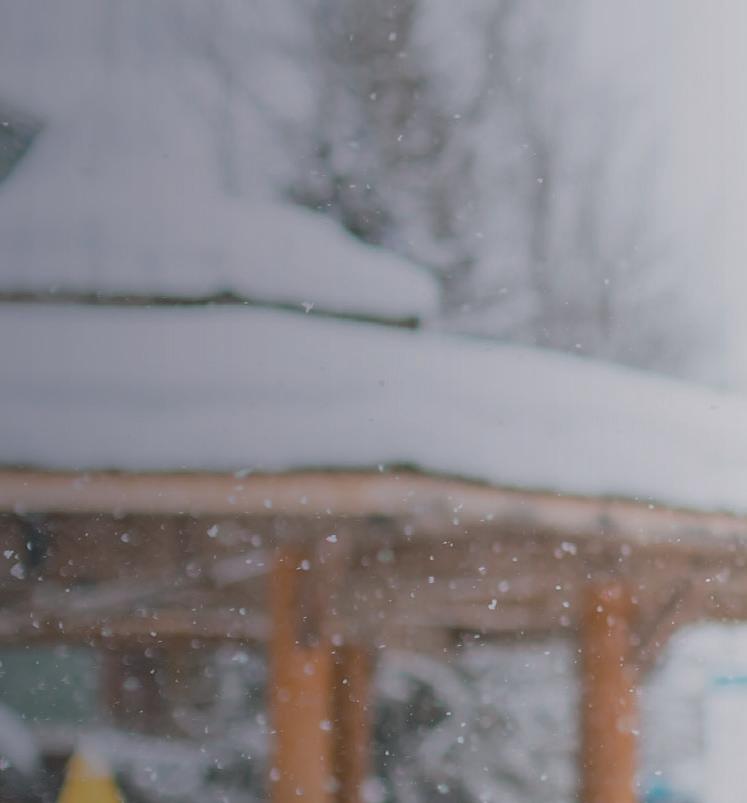




GIVEN ITS STATUS as an international tourism destination, Whistler has for years been a natural landing spot for foreigners from across the globe. Now, thanks to recently compiled data from the Whistler Multicultural Society (WMS), we can see that trend has only escalated over the past five years, even as the COVID-19 pandemic closed international borders and tourism jobs dried up.
Pulling together recently released census data, along with municipal demographic statistics from across the Sea to Sky, the WMS last week released an infographic showing diversity levels in the corridor.
Notably for Whistler, the resort’s immigrant community—which totalled 3,320 in the 2021 census—now makes up nearly a quarter of the permanent population, at 23.7 per cent, up three percentage points from the 2016 census. That’s the highest proportion of immigrants—considered a landed immigrant or permanent resident—of any Sea to Sky community, with Squamish counting a fifth of its population as immigrants; the SquamishLillooet Regional District at 19.2 per cent; and the Sunshine Coast at 18.2 per cent.
The number of non-permanent residents in Whistler—largely made up of temporary


foreign workers and their families—is on the rise as well. Even with the pandemic’s effects on the local job market, the number of nonpermanent residents grew nearly 18 per cent, from 1,185 in 2016 to 1,395 last year.
“I think that’s the case because of the economic possibilities in Whistler,” said Kira Grachev, community outreach coordinator with the WMS.
Concerns around the lack of housing and unaffordability haven’t dampened Whistler’s potential as a landing spot for foreign workers, explained Joel Chevalier, owner and founder of Whistler-based recruitment firm, Culinary Recruitment International, but the multitude of job opportunities elsewhere in the country means workers— and, particularly, skilled workers—don’t stay on the market for long.
“I have three different employers in their hiring phase and every week that goes by that they don’t make a decision, applicants are telling me they’ve got other offers and they’ll move somewhere else,” he said. “The trend is it’s an employee’s market and even employees coming from less economically strong countries still have lots of opportunities.”








While Whistler counts a high proportion of immigrants compared to its Sea to Sky neighbours, it still lags behind British Columbia and Canada when it comes to visible minorities. As of the 2021 census, 12.2
per cent of Whistler identified as a visible minority, an increase from 10.3 per cent five years prior, but still well below B.C. (34.4 per cent) and Canada (26.5 per cent).

In 2021, Filipino, Japanese and Chinese were the top three visible minorities identified in Whistler, followed by Latin American, South Asian, Southeast Asian, and Black. The most common mother tongues (other than English and French) of clients accessing the WMS are Tagalog, Japanese, Spanish and Czech.
Grachev believes that low proportion of visible minorities speaks to several factors, namely, the steep financial cost to get into skiing, as well as the sport’s Eurocentric roots.
“Definitely there’s a class question here,” she noted.


On top of that is the “layer of invisibility” to Whistler’s visible minority community that the WMS is trying to cut through.

“While you can see that visible minorities in Whistler are increasing, in what way are we all integrating into the community?” Grachev said. “That’s the real question, and if you live in Whistler, you can see quite clearly … that there is a little bit of unintended or indirect segregation of all the different populations here, and specifically immigrants. They are often working late shifts, overnight in hotels, or underground and behind the scenes.”
Beyond the language and cultural barriers newly landed immigrants can face in Whistler,


there’s also the difficulty of navigating essential services, such as banking, housing and health-care.


“If you don’t know your rights, you don’t even know you’re in a wrongful situation. You may think it’s normal and have to endure this hardship,” said Izumi Inoue, outreach worker for the Whistler Community Services Society (WCSS).
Increasingly, it’s resort employers taking on the responsibility of connecting foreign employees to local resources, today a normal component of running a business in Whistler.



“When we first started bringing in a different cultural mix—I remember when we first started bringing in Moroccans and now we’re bringing in people from Cameroon and Senegal—employers weren’t quite sure what they were supposed to do and how to do it. Now they know it’s part of that connection,” Chevalier said. “You don’t always get it right, but employees notice the difference, and quite honestly, if you’re bringing someone here, it’s your responsibility to make them feel welcome.”
The WMS is finalizing its Sea to Sky Racism, Discrimination and Bias report, based on community surveys, expected for completion by the new year. Grachev said one notable trend from the results was the identified lack of a formal outlet for anyone who may have experienced racism or discrimination locally. n




 BY MEGAN LALONDE
BY MEGAN LALONDE
WHEN A HELICOPTER -pilot friend calls you on a sunny powder day and asks if you want to go heli-skiing, the only answer is “yes.” That was as true four decades ago as it is today.
But when that friend calls and asks if you’re interested in laying down the winter’s first tracks on a newly-cut run? You grab your skis and run out the door.
That unique experience fell into Brian Tutty’s lap on Sunday, Dec. 9, 1979, one year before Blackcomb Mountain’s lifts first opened to the public. It’s one he remembers fondly, even 43 years later.
As Tutty recalled, the skies had just cleared after Whistler’s first big snowfall of the season. “The runs had been cut that summer, but the lifts were being put in next summer,” he explained.
Blackcomb president and general manager Hugh Smythe called his neighbour, Whistler Okanagan Helicopters base pilot Peter McLennan, with a question: could they go skiing?

Smythe told McLennan he wanted “to check out the fall lines,” Tutty remembered. “And Pete said, ‘Well, what are you doing tomorrow?’”
Smythe had laid tracks on Blackcomb’s slopes countless times before, but those runs usually included more bushwalking than
float-y powder turns.
Throughout the winter of 1978-79, Smythe and planner Mike Collins skied through the trees “pretty much every day,” Smythe recalled. “It sounds like it was epic—on a really nice day it was great—but most of them weren’t quite as nice,” he said with a laugh. “On a good day, we’d get about three runs. As it’s not just skiing, it’s, you know, traversing back and forth and looking at the terrain and following some of the mapping that had been done.”
Luckily for Tutty—he and McLennan had recently procured a cabin in White Gold— the pilot had space in the chopper for a few friends. The men headed up with a small


group that also included Don Anderson, Brent Wallace, Brian Worth and Nicki Valentine.
“To go up in the chopper, with the first group of public guests was really, really a hoot,” said Smythe.
As Valentine remembered, it was a day of “firsts.” Her “First time in a helicopter and first time skiing this new mountain Blackcomb, before anyone had skied it,” she recalled in an email. “I’m not sure which was more exciting.”
She added, “I do remember coming down that last slope, in powder snow, hoping no rocks or slash lurked below, as it was early in the season. And waiting for us, was Peter McLennan, our pilot and friend. Amazing
experience, I was very lucky to be included!”





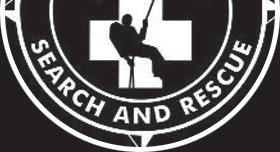

McLennan snapped a photo from the helicopter as the group approached the pickup point, slightly above and to the southeast of where the top of Excalibur Gondola sits today. Tutty donated the photo, signed by the skiers in the frame, to the Whistler Museum on Nov. 17.
For decades, the photo was forgotten in Tutty’s basement in Nanaimo, hidden behind another cherished picture of Black Tusk during sunset. When the glass covering that photo broke, Tutty recovered the treasure. He called his old friend, Valentine, who suggested framing the shot, “and then it evolved from that point,” Tutty said.
“My daughter said, ‘Dad, you’re going to give this away?’ and I said well, I’ll donate it to the museum so others can appreciate it,” said Tutty, adding that he suffered a heart attack earlier this year.

Despite that scare, Tutty’s loaded up with passes for both Whistler Blackcomb and Mount Washington and is looking ahead to another winter on the slopes. “I hope I can keep skiing,” he said. “I’ve been skiing since I was 12.”
Whistler Museum, meanwhile, is “very happy” to add the image to its collection, said curator Brad Nichols.



“We’re going to preserve this stuff, not for the next five, 10 years, but for hundreds of years down the road. That’s the whole museum game,” he said. n



different parts of the property, with often up to five bears observed onsite at a time. They also overheard Stevikova calling the bears by name.

A WHISTLER WOMAN who was fined $60,000 this fall for her role in feeding black bears from her Kadenwood home has successfully appealed her sentence and had her fine significantly reduced.
On Dec. 1, Zuzana Stevikova, who pled guilty early in the proceedings, was ordered to pay a lowered fine of $10,500, according to court documents.

The investigation was launched in July 2018 after the Conservation Officer Service (COS) received an anonymous complaint claiming that residents of the wealthy neighbourhood had been deliberately feeding bears “for a considerable amount of time.”
A sow and two cubs that were fed in Kadenwood were later killed by the Crown agency in September 2018 after displaying “very troubling” behaviour on the scene, conservation officers said at the time.
Local grocery clerks interviewed by the COS said Stevikova and her partner, Oliver Dugan—whose charges were eventually stayed—purchased up to 10 cases of apples, 50 pounds of carrots and 15 dozen eggs on a weekly basis. Witnesses, most of whom worked in the area, reported to investigators seeing apples or carrots “strewn about” on
The COS called the initial $60,000 fine handed down in late September the highest overall penalty ever imposed under B.C.’s Wildlife Act. According to Justice J. Miriam
offences took place. Ultimately, sentencing judge Lindsay Smith found the amount didn’t satisfy the public interest, justifying the harsh penalty, in part, due to the deliberate and repeated nature of the offences and the risk posed to both the bears and the public.
In striking down the earlier sentence, however, Gropper said the sentencing
whether the bears that were euthanized were fed by Ms. Stevikova,” adding that “witnesses were vague and potentially unavailable,” and that the evidence was impacted by the amount of time between the witnesses’ statements to conservation officers and the subsequent trial.
Furthermore, while the Crown pointed out that the evidence showed Stevikova’s bear-feeding was likely limited to three or four days, sentencing judge Smith considered her actions “deliberate and planned and that she repeated the offending behaviour throughout the summer of 2018,” the court documents read.
- J. MIRIAM GROPPERGropper, the steep fine—which was nearly six times the amount proposed in the original joint submission by the Crown and defence— did not align with penalties handed down for similar offences in the past.
In the relatively rare joint submission, the Crown and defence counsel had earlier asked for a smaller $10,000 fine to be imposed, which took into consideration, among other factors, Stevikova’s early guilty plea, her high moral culpability and the number of days the

judge failed to properly apply the necessary principles from the applicable case law, and “made findings of fact which were not supported by the agreed statement of facts, would be difficult for the Crown to prove, or were not based on evidence but rather her own judicial notice. She then fashioned a sentence based on her extrapolation of the facts before her.”
In Gropper’s analysis of the Crown’s case, she noted “a lack of direct evidence about
The “overwhelming theme” in the reasons for Smith’s initial judgement, Gropper wrote, was “the foreseeability of the bears being euthanized as a result of Ms. Stevikova’s actions,” particularly given the signage and messaging found around Whistler advising that “a fed bear is a dead bear.”



The Crown’s submissions, however, made clear that taking judicial notice of this messaging was wrong because the death of the bears “is not necessarily always the outcome of COS intervention.”
According to the court proceedings, Stevikova noticed the bears “looked skinny” and, by feeding them, believed she was preventing the public from calling the COS, which she thought would ultimately lead to their deaths. n
“[There was] a lack of direct evidence about whether the bears that were euthanized were fed by Ms. Stevikova.”
IF RESIDENTS OF Fitzsimmons Walk in Whistler’s White Gold neighbourhood had their way, a newly redesigned affordable housing project at 7104 Nancy Greene Drive would not proceed in its current form.
On Nov. 29, more than half a dozen people voiced their opinions on the 36-unit development at a public hearing held over Zoom for its rezoning.
Though many voiced unhappiness with the current design, not all are against the development so long as it addresses neighbouring residents’ concerns around parking, setbacks, loss of ecology and density.
“This project is just too large to fit the neighbourhood; 36 units should be 24 units,” said White Gold resident James Thompson at the public hearing.
“We’re not against employee housing whatsoever. We think you need it, and there’s plenty of opportunity for it to be done. But you have to take it in steps, and it has to fit with the community.”
Dave Lakey echoed that sentiment. Lakey is involved with the Fitzsimmons Walk Strata Council and believes the
proposed location at the intersection of Highway 99 and Nancy Greene Drive is not a good fit for the neighbourhood.
“If we fit something in there that doesn’t fit with the community, it will stand out so blatantly … if they overpack that spot and it fails to function properly in the community, it’ll look bad for employee housing,” Lakey said.
public hearing in total, with opinions evenly divided. The RMOW also received a dozen written submissions from neighbouring residents, most of whom opposed the project.
First proposed on Jan. 9, 2018, the project has undergone several redesigns and shrunk substantially from 65 units to just 36 in the current proposal.
election the real need for employee housing, and rental buildings help to make sure that the people working in the community have housing,” said Sue Maxwell.
“I’d much prefer to see increased density in the heart of our community than to have more sprawl further away.”
Maxwell and other proponents cited the location—close to the village centre, transit, and a grocery store—as a good spot for increasing density in Whistler that isn’t car-dependent.
“With the sheer number of people who are looking for housing here, and with the climate crisis upon us, I think it’s suitable to build buildings that aren’t necessarily cardependent and that we focus on providing housing for the people who don’t necessarily have vehicles,” said Maxwell.
Other Whistler residents who spoke in favour of the project at the hearing also favoured increased density.

“You’ll have other people not wanting that same situation in their backyard, and that’ll build NIMBYism and won’t fix it.”
To address concerns about parking, the Resort Municipality of Whistler (RMOW) and developer Vidorra Developments created a parking management plan to alleviate some of the issues that may arise from the development.
Eight people made comments at the
The percentage of affordable housing in the project has also been reduced, from 100 per cent of units rented at below-market rates to 50 per cent.
Many residents in favour of the project cited the housing crisis in the municipality and advocated for the project to have increased, rather than decreased, density.
“We heard loud and clear in the last
“I strongly urge, if any revisions are made, take the size of the building back closer to what was originally proposed and eliminate the parking so that more units can be provided for the same money,” said Michael Burnett.
Council will consider the public hearing submissions prior to third reading of the related rezoning bylaw.
Read more at whistler.ca/housing. n

“I’d much prefer to see increased density in the heart of our community than to have more sprawl further away.”
- SUE MAXWELL
 BY KARL RICKER
BY KARL RICKER
WHISTLER’S UNUSUAL weather patterns this year affected the abundance of many bird species, but not overall biodiversity. Over the past year, 188 species were seen, which is tied with the record year. Noteworthy for this year are the sharp eyes and sensitive ears of the women in our ornithological corps: Nicole McHugh, Maeve Jones, Dea Lloyd, Heather Baines, and Liz Barrett. Season by season, here are the anomalies and highlights.
WINTER (DEC. 1, 2021 TO FEB. 28, 2022)
The Christmas Bird Count organized by Shawn Mason suffered from the rains of November. It gave us a lean 35 species, and very low counts on most of them. By Feb. 28, we saw 64 species, a few above average. The “Bird of the Season” was a boreal owl seen over two days near the bird viewing platform at Alta Lake. This was Whistler’s fifth record of the species, which usually inhabits the north end of our province.
Despite the crummy wet weather, 152 species were seen (above average) thanks to the Cheakamus Crossing hotspot. The “Bird of the Season” was the first record of the American white pelican, highlighted with a great photo in Pique’s feature story on May 5. Let’s make it the “Bird of the Year.”
A wet start, which continued into midJuly, hampered the number of warblers and sparrows. There were several surprising “no shows” counteracted by rare finds: a Western kingbird (a flycatcher) and Bewick’s wren (last seen in Whistler in 1982). However, the “Bird of
the Season” was a very colourful lazuli bunting seen at Cheakamus Crossing. But perhaps this honour should be shared with a Say’s phoebe seen at Nicklaus North.
Hot and dry weather continued for another seven or eight weeks. The migrants from the north refused to move; the songbirds stopped singing; “our” osprey nest remained active (the parents left at the end of September, while the junior finally departed on Thanksgiving); and slowly American coots arrived at Green Lake.
Bang! Nov. 1 saw a classic overnight “down drop” of more than 1,000 waterfowl on Green Lake. Maeve phoned for reinforcements to help with the count, and by late afternoon we had recorded 20 species and 1,149 birds, which included record one-day counts on the following: Northern shovelers (36), greenwinged teals (129), American wigeons (350), ring-necked ducks (270), buffleheads (470), coots (455) and a few days later, hooded mergansers (our only all-season duck) (32). Most of these big numbers dwindled drastically on Nov. 2 or 3, except for the coots and wigeons, which usually disappear by the end of November.
The “Bird of the Season” is the Sabine’s gull, an arctic nester and oceanic migrant to sub-equatorial waters for winter. It was seen by Dea in mid-September and photographed at the Fitzsimmons Delta a couple of days later. Season total: 119 species, 13 above average.
Please join us for the Christmas Bird Count coming up on Dec. 14. All are invited to take part regardless of experience. The more eyes and ears on the job equates to more birds! For more information, please go to: whistlernaturalists.ca/birding.
Naturespeak is prepared by the Whistler Naturalists. To learn more about Whistler’s natural world, go to whistlernaturalists.ca. n

 GULL IT OVER This Sabine’s gull, photographed at the Fitzsimmons delta, is autumn’s “Bird of the Season.”
GULL IT OVER This Sabine’s gull, photographed at the Fitzsimmons delta, is autumn’s “Bird of the Season.”
OCT. 21 WAS supposed to be the start of an average weekend for Pemberton local Lennox Davies. Instead, he ended up saving his close friend’s life.
Davies, an 18-year-old communications and kinesiology student at Capilano University, was packing up to visit home that day when his phone rang. It was a call from Oliver Richman, whom he’d known since “before he can remember.” The young men grew up skiing and playing soccer together, so when Richman invited Davies to his New Westminster home for the night,
Davies changed plans and headed south 10 minutes before he was supposed to drive north for the weekend.
You can call it chance, the will of God or anything else you want. The fact is, Davies was in the right place at the moment Richman needed him most.
The longtime friends played video games deep into the night, as many young men are known to do. Davies was mildly annoyed at losing a game of FIFA and suggested they watch TV instead. Richman hopped onto his bed to do so, and Davies heard something hit the wall. At first, he assumed it was the game controller, or perhaps Richman had smacked his head by mistake.
Then Richman started snoring—but doing so very unusually. Davies describes it as “cartoon snoring.”
“I stood up and tried to talk to him, and there was no response at all,” Davies recalled. “He didn’t respond to touch, didn’t respond to
sound. That’s when I kind of realized, oh sh**, this is not good.”
In truth, Richman was experiencing ventricular tachycardia: an abnormal condition where the heart’s lower chamber beats too fast to pump efficiently, leaving the body deprived of oxygenated blood. Sustained ventricular tachycardia can lead to cardiac arrest—which was exactly what Richman had just gone into.
“I just remember trying to think and not being able to,” Davies said. “I was trying to be like, OK, what can I do here? What are my options? But I just felt like I was completely clouded.”

It had been three years since Davies was trained in CPR as part of the outdoor program at Pemberton Secondary School. He never thought he would have to use it on a fellow 18-year-old, a close friend. Yet with Richman

unconscious in front of him, adrenaline cleared the clouds and launched Davies into action.
His training and instincts proved sound. Davies forklifted Richman out of his bed and lowered him to the ground, ensuring he was flat on his back to clear his airway. The kinesiology student dialed 911 and then put his head down, doing chest compressions for about 15 minutes. By Davies’ estimation, Richman briefly gasped for air about four minutes in. He gasped again roughly six minutes after that.
At this point, it was about 2 a.m. on Oct. 22. First responders had arrived and were asking Davies if the front door was unlocked. He knew it wasn’t. The 911 operator advised Davies to move the next time Richman gasped.
“I don’t think I’ve ever run that fast in my life,” the Capilano student said of the moment he bolted to open the door.
Exhausted from doing chest compressions, Davies could only scream raggedly to guide
LIFE SAVER Pemberton teens Lennox Davies (right) and Oliver Richman.paramedics to Richman’s location in the house. He promptly allowed them to take over as a tidal wave of relief mixed with trepidation flooded him. Doubt infiltrated his mind as he sat just outside the room, listening to the first responders work: “no heartbeat, no pulse.”
“There was so much adrenaline and so much emotion going through me that it was so difficult to speak,” Davies recalls.
He lifted his head when the paramedics reported a pulse from Richman. When he separated his hands, something splashed to the floor. At first, Davies wondered if he was bleeding for some reason. He wasn’t.
So, what had dampened the floor? It was the tears that had pooled in his hands.
When first responders asked Davies if he was OK, he said yes—because compared to Richman at that time, he was. They departed for the hospital, and he called his mom, knowing for sure that he needed someone to talk to, someone to give him a second opinion. Davies felt that he couldn’t stay in Richman’s empty house anymore, which was so quiet that “you could hear a pin drop on carpet.”
Instead, he called an Uber and went to the hospital, bringing with him Richman’s wallet, phone charger, shoes and clothing. Davies wanted to be there for his friend.


Only Richman’s immediate family members were allowed into his room, so Davies waited outside, trying to field questions from hospital staff as nightmarish what-if scenarios hijacked his train of thought. At first, he struggled to calm down, but spending hours on the phone with his own parents and Richman’s father, Mike, seemed to help him focus.
When Mike, the mayor of Pemberton, arrived, Davies immediately pointed him towards the front desk. “The lady there will know where your son is,” he remembers saying. “Go to Oliver. Go to Oliver.”

Mike rushed off, and Davies hoped with all of his soul that he would return bearing good news. Fortunately, that’s what happened. Oliver Richman would be OK, and Davies felt like he was “able to breathe again.”
“I remember letting out a breath of air and I was like, OK. I just saved his life,” Davies said. “He’s alive because of me. And as soon as I walked out of that hospital, I was just like, crying out of complete joy and complete happiness.
“I don’t think I’ve ever felt that happy in my life. I don’t think I ever will again.”
Mike Richman offered to drive Davies back
to Pemberton, but he declined, encouraging his friend’s father to stay at Oliver’s bedside. Instead, Davies called another Uber to reach his grandparents’ house, talking with his mom while he waited. His adrenaline rush didn’t seem to subside until Oct. 23, when he was driving back to Pemberton and alone with his thoughts on the Sea to Sky highway.

Davies feared that others in his community would bombard him with questions about the incident, but he credits Richman’s mother, Tanya, with helping him stay largely anonymous. When some mutual friends inevitably put two and two together, he admitted to his involvement but requested privacy to process his emotions.
So why has Davies now chosen to tell his story? He understands that other people have been in his situation before, and others still may be placed there in the future. He realizes that had he not paid attention to his high school CPR training, the outcome of this story could be much different.
Davies hopes that many others will pursue first aid training and take it seriously, not just so they gain potentially life-saving skills, but also so they can learn to deal with the bleak hypotheticals that plague one’s mind during a stressful situation.
“If I can put out a good example of what to do and how to act in those situations, maybe it can save somebody else’s life,” Davies said. “The fact is, the what-ifs are always going to be worse than the situation at hand [and] they distract you from what’s really happening. That’s the main thing for me: giving people as much information as I can to help them in a situation where they might need it. You never know when they’re going to cross that bridge.”
Richman, as of this writing, feels well and is getting back into everyday life after having his stitches removed. He is coaching basketball at Pemberton Secondary School as he awaits the next checkup, which will hopefully clear him for full exercise. A resilient young man, Richman looks forward to getting over what he calls a “speed bump” so he can get back to studying sport sciences at Douglas College.
Above all, he is grateful that his relationship with Davies has become even stronger.
“Once we went to university, we didn’t hang out for about two months until I asked him to hang out on the night where it all happened,” Richman said. “This has definitely brought us closer and created a lifelong friendship.” n
































































































































































Surefoot’s proprietar y fitting process fits you into the most comfor table and best per forming boot you could imagine, immediately. With 3D imaging, custom fit insoles, memor y foam injected liners, and an integrated heating system, you ’ re ready for the best skiing of your life in just over an hour Whether you ’ re a beginner or a seasoned exper t, Sure foot has the right boot for you Come in and experience the Surefoot difference today.
SKIER: Camilla Fraschini, Surefoot buyer (6 yr.)
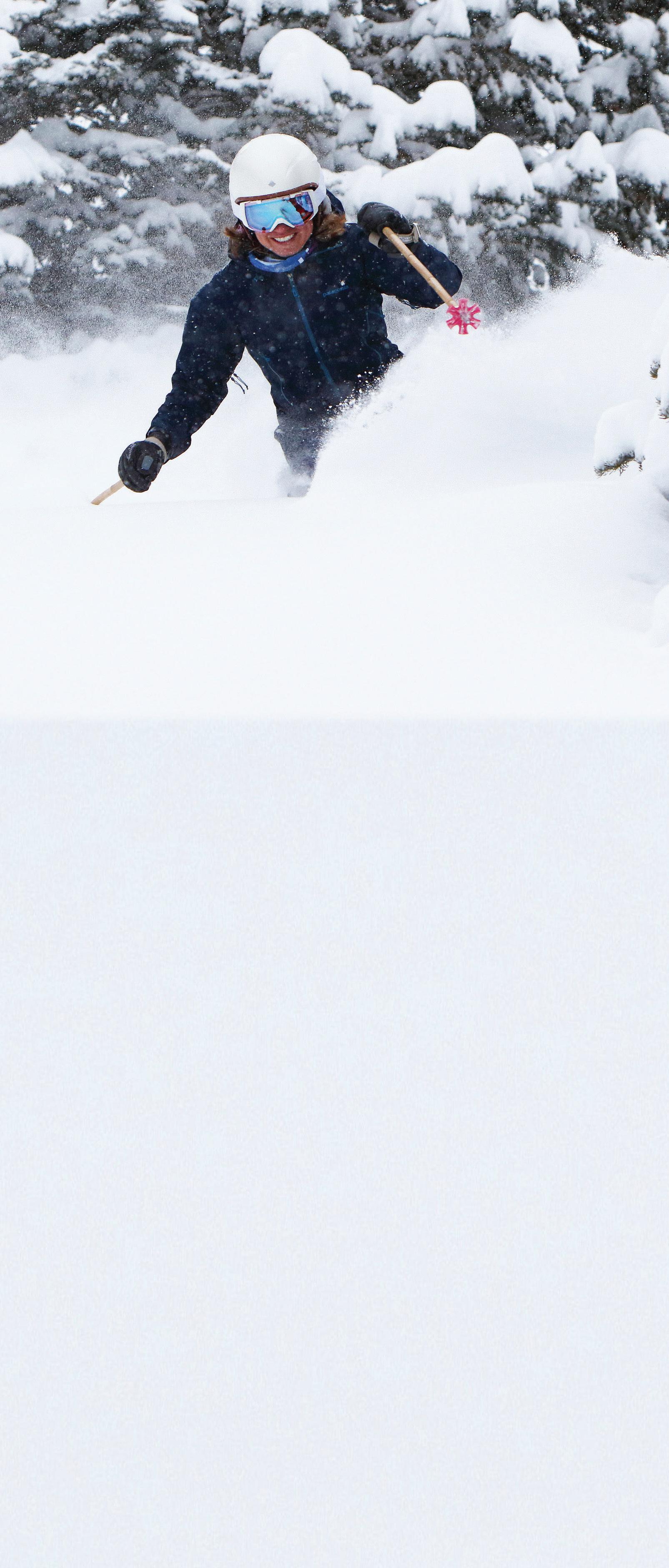



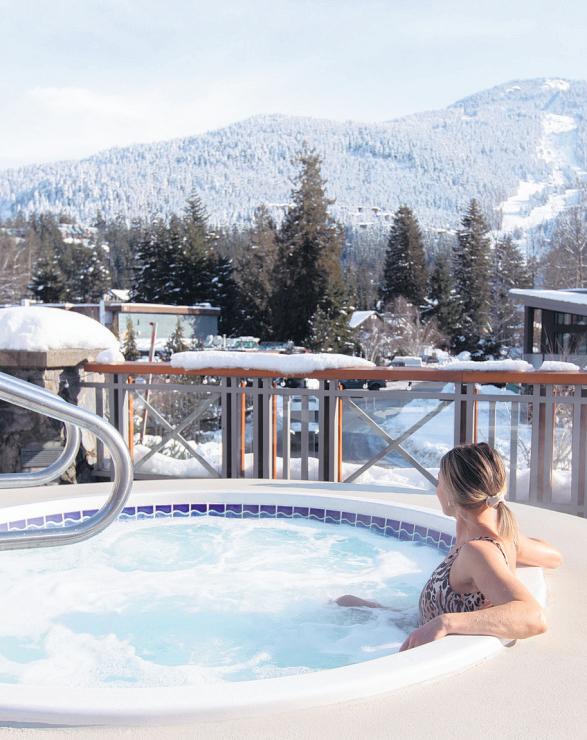




































































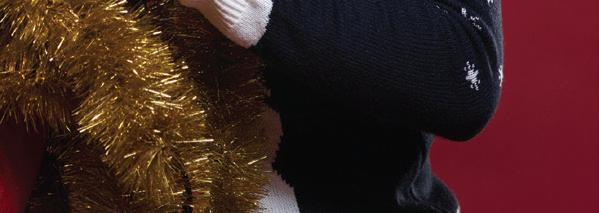




















































I’LL ADMIT I’m not a fan or follower of professional team sports. Conversations my friends have about fantasy hockey team drafts, trades and statistics go way over my head. Not that I experience FOMO on nerding out over how many assists some player managed last night. From the perspective of an outsider looking in at professional league clubs like those found in the NHL, NBA and UEFA, there is an almost religious devotion by the most fervent fans. Say what you will about it being
BY VINCE SHULEY






all about the money, but the business model works because these games demonstrate some damn fine skill, athleticism and teamwork all in the name of entertainment.
When the players represent their nations, however, things get more patriotic. All those feuding club fans put aside their perennial
differences and cheer as one voice under their country’s flag. And nowhere is this patriotism more fervent than at the FIFA World Cup.
I’ll make a quick note here that I don’t agree with how FIFA is run, corrupt as it is. And I do agree with the public sentiment that Qatar was a terrible choice for a World Cup venue with its 38 degrees Celsius temperatures and a long list of human rights violations. You can read more about Qatar’s questionable hosting of the World Cup on any number of credible news sources and find out more about FIFA’s corruption in the Netflix documentary FIFA Uncovered. I would support any successor organization that could supplant this collection of old boys lining their pockets, but for now, it’s our only way to watch the World Cup.
After a euphoric World Cup qualification— its first since 1986—Canada had a humbling campaign that wrapped up last week. While the Canadian squad won no games, it did outperform the 1986 effort with two goals scored (for context, the 1986 team scored no goals). The star that everyone is talking about is Alphonso Davies, who is considered one of the world’s best left-backs and plays for the powerhouse German club FC Bayern
top-tier German league from the Vancouver Whitecaps in a $22-million transfer deal. Last week, Davies made Canadian sporting history with a goal against Croatia, the first by a Canadian men’s team at the World Cup. Canada lost the match 4-1 against the 2018 runner-up, but progress is progress.
Over the last couple of weeks, I had a great time following another underdog team; the Australian Socceroos. With two of the strongest European teams in their group, including reigning World Cup champions France, Australia held its own, defeating both Denmark and Tunisia to advance to the round of 16. Argentina promptly squashed any further World Cup dreams for the Aussies, but they can return home with their heads held high.
Even if there are no more countries that I can lay claim to left in the World Cup, I’ll still keep watching. I’m cheering for underdogs such as Japan, which managed two big upsets in its group games, beating Germany and Spain, both former World Cup champions. South Korea has also been one to watch, with a victory over Portugal advancing the squad to the round of 16. By the time you read this, most of the underdogs will have been eliminated, but hopefully they went out with a bang and gave the European and South American powerhouses a run for their money. This World Cup has seen some massive upsets
already, so I wouldn’t be surprised if we see two unlikely teams battling it out in the final.
While Canada’s World Cup dreams may be over, qualifying for the 2022 World Cup will have a lasting impact. The BTB (Born to Be) Soccer Academy—which serves underprivileged and diverse immigrant communities in North Edmonton, and where Davies trained in his youth—has been around for just nine years, and this year 14 of its players were awarded university scholarships while six others signed with the Whitecaps MLS Academy. With Davies’ goal against Croatia putting Canada another small step forward, young players up and coming through academies such as BTB have their sights set on the 2026 World Cup, which will be co-hosted by Canada, the U.S. and Mexico. Canada will automatically qualify as a host nation, giving it another opportunity to raise its stock in The Beautiful Game.

Canada’s hockey teams are legendary. But with a gold medal from the Canada women’s national soccer team at the 2020 Olympics and an important goal at the 2022 Men’s World Cup, there’s room to see what the Great White North can do off the ice.

Vince Shuley jumps on the soccer bandwagon every four years. For questions, comments or suggestions for The Outsider email vince.shuley@ gmail.com or Instagram @whis_vince. ■


This article was produced by the Hakai Institute, which conducts scientific research from ice fields to oceans in B.C. and beyond. Read the full version here: hakai.org/the-demon-river.

 By J.B. MacKinnon /
By J.B. MacKinnon /
On the night of Nov. 15, 2021, British Columbia’s Nicola River sounded like thunder.

Boulders boomed beneath a raging current that was bursting its banks, taking out everything in its path.
Residents along Highway 8 were devastated. But they were not alone.
Communities all over southwest British Columbia felt the impacts of flooding and landslides unleashed by an “atmospheric river” rainstorm.
It was the costliest disaster in the province’s history, resulting in an estimated $13 billion worth of damage.
Yet no place experienced flooding like the Nicola Valley, a
dry-belt area that rarely sees extreme rain.
A year later, J.B. MacKinnon recounts an extraordinary flood on the Nicola River that laid waste to homes and lives— and the idea that we control nature.
To the list of moments when automotive GPS has given very bad directional advice, we can now add the case of Const. Brett Schmidt of the Royal Canadian Mounted Police.
On the morning of Monday, Nov. 15, 2021, Schmidt was on an off-duty visit with his girlfriend in Kamloops, a city in the arid plateau region known to British Columbians as the Interior. From there, he planned to make the long drive to his home in a suburb
of Vancouver, on the shores of the Pacific Ocean.
In between Kamloops and Vancouver are the Coast Mountains, which roughly divide southern B.C. into wet and dry country. Slopes and valleys westward of the peaks catch precipitation blowing in from the sea and are famously soggy, while the Interior to the east lies in their rain shadow and, in places, resembles a desert.
Unfortunately for Schmidt, heavy rains on the wet side of the mountains had triggered floods and mudslides there, blocking three of the four highways he might have used to get home. Schmidt was unfazed. Road closures in southern B.C. come as no surprise in any season but summer.
He was left with Highway 99, a less-travelled road that would, on a day with better weather, be described as the scenic route. A couple of hours into the journey in his black GMC pickup, driving through rain even in parts of the drylands, he learned that Highway 99 had closed somewhere in the Coast Mountains ahead of him—another mudslide, or what geologists call a “debris flow.”
Vancouver, which is Canada’s third largest city and most important seaport, had now been completely cut off by road or rail from the rest of the country.
By a rainstorm.
There was nothing Schmidt could do but turn around. He had been on the road since about 8:30 a.m. It was now around 11 a.m. He drove back to the ruins of Lytton, an Interior town that had made international news earlier that year when it hit the highest temperature ever recorded in Canada—49.6 C (121 F)—and one day later burned down to its metals and concrete in a wildfire.
From Lytton, Schmidt turned north to follow the Thompson River. He soon reached the hamlet of Spences Bridge, which had also been evacuated during the wildfire season. There, his GPS recommended a right-hand turn onto Highway 8, a quiet connector between two more major highways. From Spences Bridge, Highway 8 follows the Nicola River upriver to the town of Merritt, retracing a route he had already driven that day.
Schmidt quickly noticed a difference. Earlier, the Nicola had looked swollen. Now it had an air of menace. The water barrelling through the near-desert landscape seemed unreal.
“The river beside the road was three times as high. It was flowing really quick,” Schmidt would later recall. “Like you could go white-water rafting on it.”
He carried on. The valley is normally a lovely one, the narrow river swaying between steep walls of rock or clay interspersed with terraces of sagebrush and bunchgrass. This year, though, wildfire had reduced whole mountainsides to black sticks jutting out of bare earth. The flames had not, at least, razed the scattered homes, or the roadside fruit and vegetable stands.
Schmidt was on a stretch of road running low along the river when he felt the ground shake under the wheels of his truck. Glancing into his rearview mirror, he saw that the asphalt he had just passed over had caved in and fallen into the churning water.

“Holy shit,” he said under his breath.
There seemed to be no better option than to keep going and hope for the best. After another few kilometers, he could see a hill in the distance where the road climbed up and away from the hungry river. If he made it there, he’d be out of harm’s way.
The hill was looming up in front of him when, as he crested a rise in the highway, he had to jam on the brakes. The road was gone. It simply ended, a jagged break. In its place was the raging Nicola River.
Nearly a century ago, in 1929, Aldous Huxley observed that there were signs we might be winning the age-old battle of “man against nature.”
It had become impossible to see a mighty river or mountain without also seeing the possibility of a mighty bridge or tunnel.
If citizens of Western civilization were falling in love with wild nature, Huxley said, there was a simple explanation. “It is easy to love a feeble and already conquered enemy.”
Sixty years later, nonfiction writer John McPhee published a book, The Control of Nature, describing an epic human battle
An account of last year’s devastating flooding of the Nicola River
to manage geological forces at supersized scales: keeping the Mississippi River from changing its course, say, or preventing flash floods from moving the San Gabriel Mountains onto Los Angeles. Were we still under the control of nature, or had we taken control of it?
In recent years, that question has come to seem firmly decided. Many now describe our times as the Anthropocene, or Human Age, with the implication that—for better or worse— we are dictating the terms of Earth’s future.
Among many such indicators provided as evidence, we have made the chicken the world’s most numerous bird. The weight of the technosphere—everything we build and make, our stuff—now outweighs all living things. Faced with a deadly pandemic, we created a vaccine in less than one year.
Most astonishing of all is climate change. As terrible a threat as it is, it’s hard not to stand in awe of our own powers: we are heating an entire planet. Our solutions to the problem include proposals for even grander engineering schemes, such as fogging the worldwide atmosphere with reflective particles to scatter sunlight back into space. History teaches that we often turn such dreams into realities, complete with unintended consequences.
Lately, though, nature has seemed to reassert itself. It has reminded us that it can be, as Huxley put it, “alien and inhuman, and occasionally diabolic.”
We have been content to think of climate change as a gradual process. But here and there, and with increasing frequency, it lurches. Unlucky people wake up to weather that doesn’t just set a new record but smashes it, that renders a familiar landscape suddenly and shockingly unfamiliar. Not just a bad day, but a bad day out of another epoch.
The makings of a very bad day on the Nicola River first took shape in the afternoon of Nov. 12, 2021—three days before Const. Schmidt turned onto Highway 8.
Just north of Hawaii, a vast reservoir of moisture had pooled in the sky, fed by a humid tropical jet stream and evaporation from an unseasonably warm Pacific Ocean.
Like water spilling out of a lake into a canyon, the moisture began to flow northeast, squeezed between a low-pressure system and a high-pressure system. In less than a day, the plume traveled 2,000 kilometres to North America’s West Coast. From space, it looked like a rushing river, and the comparison is more than fair: it probably carried more water than the Amazon, the world’s largest river by volume.
We never truly saw atmospheric rivers, as these flows in the sky are now known, until scientists produced the first images of them, based on satellite readings, in the early 1990s. In everyday life, they go by other names, such as Pineapple Express or Tropical Punch—storms that cruise up from the tropics, mainly in the late autumn and early winter, bringing stiff winds, warm air, and heavy rain.
Over time, we learned that dozens of atmospheric rivers flow up to the North American shore between California and Alaska each year—it is one of the most active atmospheric river zones on the planet.
Most of these precipitation events are valuable: a single storm can deliver one-fifth of an area’s annual rainfall, replenishing groundwater, rivers, and lakes. Sometimes, however, they’re trouble. More than three-quarters of B.C.’s disastrous floods have occurred when an atmospheric river fell out of the sky.

Atmospheric rivers have never yet been given names the way windstorms have, such as Hurricane Ian and Super Typhoon Noru. In the United States, however, a five-point scale to describe the intensity of atmospheric rivers—not unlike the ranking applied to hurricanes—was proposed in 2019. A “weak” Category 1 atmospheric river would be a beneficial rainstorm, giving comfort and succor to farmers
and ducks. A Category 5 might do billions of dollars worth of damage. A lot depends on exactly where a storm’s rain falls, and for how long.
The one pouring toward the North American shore in mid-November of 2021 was 400 kilometres wide, about 4,000 kilometres long, and looked powerful. The question was where it would land.
Armel Castellan, a warning preparedness meteorologist at the Meteorological Service of Canada, compares an atmospheric river to a fire hose. (Hawaiian Fire Hose is another of the nicknames sometimes given to these storms.)
If the nozzle is aimed at you, you’re getting drenched and pounded. Stand a little to either side, and you might not even have to worry about your suede shoes. But, also like a fire hose, atmospheric rivers tend to twist and snake. They most often
“Nobody was in a particularly alarmed state,” Castellan said. “But going into Saturday or Sunday, it was like, ‘Oh wow, this is getting pretty strong.’”
By that point, the weather-forecasting phase was largely over: the river had arrived.
Normally, atmospheric rivers that hit British Columbia run into momentous geography soon after reaching the coast. When that happens, the storms get pushed up to a cooler altitude, and the water vapour they carry turns to rain. Even before reaching B.C.’s southern mainland, which bristles with mile-high peaks, a river in the sky must get past the gateway formed by Vancouver Island and Washington’s Olympic Peninsula, both mountainous.
As the mid-November atmospheric river rolled in, however, the high pressure system to its south nudged it onto a perfect path to avoid every barrier—“threading a needle,” as Castellan puts it. The core of the storm eased over the low country at the tips of the two gatekeepers. That same angle of approach took it straight into the broad Fraser River valley and nearly a hundred kilometres inland before it finally ran into mountains.
There, the storm loomed over the Coquihalla Highway, which leads into the B.C. Interior. The river in the sky needed to flow just 35 kilometres, a tiny fraction of its length, to reach the roadway’s summit, Coquihalla Pass, where the wet, seaward side of the mountains switches to the dry, “rain shadow” side. Lush forests gradually give way to straw-gold bunchgrass.
The dry side is dry for the obvious reason that large amounts of water do not ordinarily fall there. Atmospheric rivers mostly peter out among ranges nearer to the coast. No Canadian weather model predicted that the mid-November storm, still sagging with water, would surge across Coquihalla Pass like a river flooding over a dam.

In the early hours of Sunday, Nov. 14, it did exactly that. Then it started to drop the kind of rainfall that the dry side might not have seen in centuries.
move across large regions of the coast, rather than steadily drown one particular place.
“You would never ring the alarm bell early, because you can be off by a thousand kilometres as to where it’s going to hit,” Castellan said.
To solve the puzzle of where an atmospheric river might end up, meteorologists and flood forecasters crunch computer weather models from multiple sources to see whether they tell similar stories about what is likely to happen. In the case of the mid-November storm, the models initially did agree on a trajectory: the fire hose was expected to split down the Canada-U.S. border, then shift southward and leave British Columbia behind.
Generally, the models estimated that 150 millimetres of rain would fall along the atmospheric river’s path, with some pockets receiving 200 millimetres. That’s very heavy rain even for the B.C. coast, where umbrellas sometimes seem to be reserved only for downpours so intense that breathing becomes difficult. The mid-November storm, though, was only the latest in a parade of severe weather events, including other atmospheric rivers, that had been striking the area since September.
Doug and Marlyn Wyatt-Purden are used to having strangers on their doorstep—lost travellers who never meant to turn down Highway 8, or people with car trouble.
The sign at the head of the driveway into the Wyatt-Purdens’ property, Nine Mile Gardens, welcomes these wayward pilgrims.
The use of mileage in that name, instead of the usual Canadian kilometres, is a holdover from the era before metric measurement.

What is now Highway 8 was once a trail walked by the region’s Indigenous people, the Nlaka’pamux (if you pronounce this ing-khla-KAP-muh, you’re getting close).

When colonial newcomers built a wagon road up the valley in the mid-1870s, they marked out locations by their distance in miles from Spences Bridge, and those areas are still known that way today.
Starting at Spences Bridge, then, Highway 8 runs southeast up the Nicola River for 65 kilometres to the larger town of Merritt. En route, the landscape divides into two moods. The first section, up to the point called 14 Mile, has a wilder, more remote feel, pressed in upon by mountain steeps. Upriver from there, the valley gradually takes on a more open aspect. In between the two sides is Shackan, a Nlaka’pamux community perched where the river starts twisting through canyon country.
Nine Mile Gardens stands just downstream from the canyon’s last narrow squeeze. The Wyatt-Purdens had originally settled in Ashcroft, a small town north of the Nicola
‘It’s not going to get any higher’A MUDSLIDE ON HIGHWAY 7 BETWEEN VANCOUVER AND HOPE SHOW THE VIOLENCE OF THE MID-NOVEMBER STORM. PHOTO COURTESY OF BC MINISTRY OF TRANSPORTATION AND INFRASTRUCTURE A SEGMENT OF B.C.’S HIGHWAY 8 THAT DROPPED OFF INTO THE NICOLA RIVER DURING THE FLOOD.
Valley, where Doug had worked at a bulk oil plant and Marlyn was a nurse. In 1977, they acquired Nine Mile Gardens and became pioneering organic farmers.


People who don’t live beside rivers can often be heard to say that people who do can’t complain about floods—but that judgment should surely be shaded by how flood-prone a riverside property actually is. When the Wyatt-Purdens moved into their house it had been there for 66 years, and never to their knowledge had been flooded. They then proceeded to live there 44 more years without a flood.
When they got a call at 7:30 a.m. on Nov. 15 from Nlaka’pamux friends downriver who said the water was rising, the Wyatt-Purdens weren’t too concerned.
In the early afternoon, a black pickup rumbled down their long driveway. By then, the river was higher than they’d ever seen it, and rising—it had knocked over their irrigation pumphouse, and they had moved their farm vehicles to higher ground. Doug walked over to meet the arriving stranger.
“Are you here to evacuate us?” Doug said, joking.
“Well, I actually am with the police force,” Const. Schmidt replied.
Schmidt hadn’t driven far from the dead end he came to on Highway 8. From there, it was only a few hundred metres back to Nine Mile Gardens. Schmidt was hoping the WyattPurdens had a landline telephone. Mobile phone signals get lost in the valley’s complex topography, and Schmidt wanted to alert his police colleagues in the RCMP that trouble was brewing in the Nicola Valley.
The Wyatt-Purdens did have a landline— unfortunately, it was no longer working. Somewhere to the north, downriver, the flood had already broken the link. Doug knew, though, that their neighbours at Clapperton Ranch, a mile upriver, were on a separate landline that ran to the south.
To get there, Schmidt would have to scramble across the steep, rocky slope above the bend where the river had erased the road.
Schmidt promptly set off for Clapperton Ranch. As he did so, one of its owners, Alan Simpson, was watching him.
Simpson’s day had started much the same as the Wyatt-Purdens’: a neighbour had dropped by to say the river was high. What struck Simpson was how strange the water looked.
Clapperton Ranch sits at the head of a short slot canyon, and just before that constriction, the water slows. The Nicola normally runs somewhere between sparkling clear and brown as mud. On this morning, it was black. It looked like a cooling lava flow, ebony and oozing. Simpson realized it was choked with ash and charcoal—somewhere upstream, rain was falling hard on the firescorched landscape.
Like the Wyatt-Purdens, Simpson and his partner Christine Rimmington weren’t initially too worried. Their house was separated from the water by broad hayfields and a slope that lifted them to the height of a four-storey building. They had lived at Clapperton Ranch for almost 20 years, and they knew the land. Even before moving here, they had researched it as an ideal place to grow quality hay.
“Developing this farm was the highlight of my working life,” said Simpson, who has the air of an artist or writer as much as that of a rancher and farmer. Simpson and Rimmington knew the 100-year-flood mark on the ranch, and as the river climbed well past it, Simpson drove his rugged-terrain vehicle—a Japanese brand of micro-truck—along the highway to a bend with a view downriver.
He saw Schmidt, far away and out of earshot. Schmidt, who was standing near his truck on the dog-toothed stub of pavement where the road had failed, was sussing out how to cross the scree slope above the missing section of highway.
Simpson could see that the river had dangerously undercut the pavement that Schmidt and his pickup were on. If it collapsed, Schmidt would trap-door into the rapids.
“Well,” Simpson thought, “I can’t do anything for him.”
Turning for home, Simpson soon saw that running waters now threatened the ranch’s two barns and other outbuildings. He headed down to open the barn doors so that the river could run through them, hoping this would lessen the chances that the current would tear them down. It was the same trick Hercules used to clean the Augean stables.
Driving up from the lower fields, Simpson saw the water surge behind him, rising suddenly by a metre. “It was like a tidal wave,” Simpson said. “Then it started to pull the buildings apart. And then the river really started to come up.”
In the midst of it all, Schmidt arrived at Clapperton Ranch. Using Simpson’s phone, Schmidt called an RCMP friend in Merritt. Schmidt’s fellow Mountie hadn’t heard any
the Nicola close to Spences Bridge, and by mid-morning the rising river had convinced them to head into town, where they have a suite attached to their restaurant.
Steve had shuttled back and forth to their house two more times, grabbing things they might need for what they imagined would be a short stay. By his second run, both lanes were flooded on one section of road.
Like so many others in the Nicola Valley, Steve wasn’t overly concerned. “Once the river broke the record, your mindset is, ‘It’s not going to get any higher,’” he said. “No one was really panicking. There was no urgency, no one was packing bags. The whole family—we call it the Highway 8 family—was just been-here-done-that.”
Forty-five minutes had passed by the time Schmidt concluded that Steve would not make it to Nine Mile Gardens. The short November day was beginning to fade. Schmidt fixed a new goal in his mind: he would leave his truck at the WyattPurdens’ farm and walk to Spences Bridge.

From there, he could tell the outside world that a flood was rising. He could find Steve Rice. A friend could pick him up and he could begin to put this bad day behind him.
Doug Wyatt-Purden offered to drive Schmidt back down Highway 8 until they reached the first washout. That turned out to be only a couple hundred metres away, just over a gentle hill. Schmidt got out of Doug’s pickup, put on his backpack, strapped his duffel bag across his chest, and started hiking.
He didn’t know if there’d be much highway left for him to walk on, but at least he knew the distance to Spences Bridge: nine miles. With the low November sun setting at 4:18 p.m., he had less than two hours of daylight to go.
The Wyatt-Purdens had a rain gauge: on the day of the flood, 20 millimetres of precipitation fell in fits and starts.
That’s the depth of a finger of whisky, or what Doug calls “a pretty good rainfall for our area.”
Clearly, the water that was swelling the Nicola River came from somewhere else.
Two of the Nicola’s biggest tributaries, the Coldwater River and Spius Creek, run down from the dry side of Coquihalla Pass, about 100 kilometres away from Nine Mile Gardens as the water flows.
The Coldwater is the larger of the two streamways. Halfway between its headwaters and the town of Merritt, where the Coldwater flows into the Nicola, a corrugated metal shack housed a gauge that was tracking the Coldwater’s flow, as it had done continuously since 1965. At 4 a.m. on Sunday, Nov. 14, that sensor began to report a river that was steadily rising.
reports of flooding on the Nicola River. So, Simpson called the emergency line.

He also sent a message to Steve Rice. Rice was the area’s regional director, and with his wife Paulet owns a popular Spences Bridge restaurant called The Packing House; most of all, he’s known as a can-do guy. In his message, Simpson told Rice that there were people along the highway who might need evacuation.

After all of this, Schmidt was left with the sense that he could get a ride out of the valley when Rice came upriver to check on people. Relieved, he made the treacherous walk back to his truck, then drove again to the Wyatt-Purdens’ neat red house with the white trim, where the backyard was now more river than yard.
“Steve’s on his way,” Schmidt told the Wyatt-Purdens.


In fact, Steve was not on his way. The Rices already knew there was no way upriver. Their home and small farm was on
Even in summer, Coquihalla Pass, 1,200 metres above sea level, is nearly empty of anyone but drivers humming along the Coquihalla Highway between B.C.’s Interior and its coast. By noon on Nov. 14, even the traffic was gone, because flooding and debris flows had slammed the highway shut.
The atmospheric river hadn’t just breached the pass. It was holding its position there, drenching the area hour after hour.
The rain was falling on a landscape primed to make matters worse. Autumn snowfalls, including a fresh layer laid down by a cold front just ahead of the storm, had turned the mountains white. When snow is deep, it can act as a sponge and absorb a rainstorm. But it wasn’t that deep. When the atmospheric river arrived, its warm air and rain turned the snow into liquid.
Among the summits that feed the Coldwater River and Spius Creek, the rain and snowmelt together, if spread evenly, could have covered the landscape with 12 centimetres of water. Some areas recorded twice as much—nearly enough to
submerge a grade-school ruler stood on end.
Under normal circumstances, the forests and soil would drink up a lot of that water. That didn’t happen either, because an unusually wet fall season had saturated the land. The unusually hot summer, meanwhile, had left a large area around the Coldwater River incinerated by the July Mountain wildfire.
In an intense fire, the ground litter of leaves and twigs can vaporize into a gas that penetrates the soil, then cools to form a waxy film. An early study explaining this chemical reaction described this waxy layer as “extremely non-wettable”—water runs right off it.
The land’s saturation, combined with water-repellent soil in the burn zone, sent the atmospheric river downpour swiftly into the Coldwater River and Spius Creek, creating what John McPhee once called “more flood for less rain.”
Except that there wasn’t less rain. Scientists would later conclude that the greatest factor by far in the flooding was the godawful sheer volume of water that fell from the sky.
To understand how surprising this outcome was, consider the fact that the provincial River Forecast Centre, which predicts streamflows across British Columbia, had only two of its five hydrologists—as people who study Earth’s water systems are known—working that weekend.
“Forecasts were looking not so bad,” said David Campbell, head of the centre and one of the people on the job as events unfolded. Since weather models did not predict serious rainfall on the dry side of the mountains, computer models of river flows didn’t predict serious flooding.
As the day wore on, the Coldwater River gauge, nearby weather stations, and even social media posts were clearly indicating that the storm was dropping a whole lot of water on Coquihalla Pass. “We ran the model and sort of just forced rain into the model,” Campbell said. It showed that the Coldwater River was likely to flood. “That was pretty much the time where we pushed the button on the flood warnings for the Coldwater.”
It was 5:30 p.m., and the Coldwater was rising toward the kind of water volume only seen every half-century. In what would later prove to be a clear oversight, the River Forecast Centre did not simultaneously issue a flood warning for the Nicola River, even though the surging Coldwater flowed straight into it.
The centre was by then seeing potential flooding in streams along the entire length of the atmospheric river’s landfall, from Vancouver Island, off B.C.’s West Coast, to the Interior. They had shifted into a mode of reacting in the moment, and they weren’t picking up a problem on the Nicola—yet.
The National Hydrological Service, the federal team responsible for the gauges that provide critical information to agencies like the River Forecast Centre, was similarly caught off-guard. When rivers flood, debris or shifts in the river channel can damage river gauges or render their data unreliable. On the morning of Nov. 14, David Hutchinson, regional chief of the hydrological service, started trying to organize two-person teams to get eyes on river stations like the one on the Coldwater.
“I realized this is a much bigger event than was anticipated,” he said. His first task, though, was difficult in the most ordinary way: it was the weekend, and no field staff were standing by, because no weather disaster had been expected.
There was another, subtler challenge. Flood forecasting relies heavily on computer modelling, but Campbell said that human judgment is still more important: in this case, the experience, skill, and knowledge of his team.
What happens, though, when an event is stretching beyond the experience of the team, beyond living memory, and beyond what is known from history? “As hydrologists,
we recognize that those kind of events could happen,” said Campbell. “But they’re almost a little more theoretical than something that we anticipate or expect to see.”
Along the Nicola River and its tributaries, river gauge readings go back only a century, and even across that timespan they’re spotty. Saying what a 100-year or 200-year or 500-year flood looks like on these rivers is therefore an educated guess extrapolated from the available data.
Two points, though, are clear enough. The first is that extreme floods are, by definition, rare. The second is that flooding on rivers like the Coldwater and Nicola typically happens in spring, when rising temperatures melt the snowpack.
Even hydrologists, then, may lean toward the same belief that was common among residents of the Nicola Valley—that a flood that is already bad isn’t likely to get a lot worse, especially in autumn. What makes the difference for scientists is that they are typically able to track data that might tell them otherwise.

After that, in dark of night, and in an expanding black hole of data, it was simply a matter of water running downhill, off the slopes and into the tributaries, and down those tributaries to the rising Nicola River.

November is not the most scenic month in the Nicola Valley. The fall leaves are mostly off the cottonwoods and Saskatoon berry bushes, leaving only the deeper greens of pine and fir.
There’s still a fine scent of sage in the air, but the roadside quackgrass is straw-coloured, the rabbitbrush topped with desiccated flowers.
The only notable birds at this time of year are the ones that always seem to watch over our human misadventures: crows, ravens, black-billed magpies.
Clapperton Ranch was home to another of the government’s water-level sensors, and it had been a loyal servant. Readings from this station on the Nicola River stretch back to 1911— more than a century of data.
At around 10:15 a.m. on Monday, Nov. 15, it stopped transmitting. Later, Alan Simpson would watch the river crest the roof of the gauge house, after which the whole structure was carried away.
Downstream, Const. Schmidt’s journey had begun to thread together the valley’s stories. Soon after leaving Nine Mile Gardens, he passed a 35-year-old steel bridge stretching across the river to Osprey Ranch. The ranch had been run as an orchard by Geoff Bannoff since 2005, producing what Bannoff called “probably the best apples in the world.”
Bannoff had started the day leading a meditation session in Vancouver, where he lives. Around noon, he checked the daily report from the River Forecast Centre and lost any sense of serenity. It predicted that the Nicola River could reach a flow rate—what hydrologists call a river’s “discharge”—of 850 cubic metres of water per second.
That’s not a lot compared to any number of big rivers, but for the Nicola, it was freakishly high.
In 2018, Bannoff had seen the river hit 350 m3/s, and there was still nearly two metres of air between the river and the bridge. From this he concluded that the bridge could survive even a once-in-a-century flood on the Nicola, estimated by hydrologists at 420 m3/s—only 20 per cent higher than he’d observed.
The Nov. 15 forecast of 850 m3/s, though, amounted to nearly 145 per cent more than he’d seen in 2018. The figure was so extreme that Bannoff thought it could be an error.
Unfortunately, the sources of that data were in trouble.



Five river gauges were providing information about what might happen on the Nicola River: two on the Coldwater, two in Spius Creek, and one keeping tabs on the Nicola itself.
In the mid-afternoon of Nov. 14, one of the Spius Creek gauges started sending wonky signals—it was measuring atmospheric pressure rather than water pressure. Most likely the sensor had been levered above the surface by debris. A couple of hours later, after sunset, the second Spius gauge began sending signals “like a ribbon blowing in the wind,” said Hutchinson.
Then the Coldwater gauge that had been giving readings since 1965 joined them, failing completely at 7:10 p.m. The station would later be found tipped on its side, destroyed, in a jumble of logs. When the river began rising, it had been chestdeep where the sensor was reading; when the gauge failed, it was deep enough to submerge a school bus—and still going up.
Schmidt, trekking past the steel bridge with the rushing torrent beneath it, would be the last person to see the bridge still standing. Only scattered showers fell from the sky, meagre explanation for the strangeness of a violent, swollen river amidst the dry landscape. Sometimes he walked on what was left of the road, sometimes through the sagebrush scrublands. At one sawn-off section of highway, the only way forward was to climb a high bank of hard-packed clay.
“Perfect,” he said aloud to himself. Then over the hill he went, dodging mats of brittle prickly-pear cactus on slopes otherwise crossed only by bighorn sheep.
Schmidt passed through the small Nlaka’pamux reserve on Kloklowuck Creek, now cut off from anywhere else by road, but still high and dry. Next up on the riverfront was the sign for Mountain Shadows Ranch, decorated with upturned horseshoes. This was the home of Linda Wiebe.
Linda had retired to the Nicola Valley in 2015 with her husband, Roy, who had recently moved into a seniors’ lodge

‘IMARLYN AND DOUG WYATTPURDEN PURCHASED NINE MILE GARDENS IN 1977. THEIR HOME WAS BUILT IN 1911 AND TO THEIR KNOWLEDGE HAD NEVER BEEN FLOODED. PHOTOS BY BENNETT WHITNELL/HAKAI INSTITUTE ALAN SIMPSON STANDS AT AN OVERLOOK ABOVE CLAPPERTON RANCH, WHICH HE BOUGHT WITH HIS PARTNER CHRISTINE RIMMINGTON IN 2002 TO GROW HAY.
in the town of Lillooet. Linda made the hour-and-a-half-long drive to visit him several times a week.
Like many properties along the Nicola River, Mountain Shadows Ranch was located on a “point bar”—the inside of a riverbend. It’s a sensible place to be, since rivers tend to erode their banks on the outside of their bends. Linda had fallen in love with what she called “the ever-changing river.”
As that river swelled on Nov. 15, she reached out to her stepson, Steve Wiebe, who was living in Surrey, Vancouver’s largest suburb.
In their first call, she told Steve that it had rained a lot in the night and the river was high, but she wasn’t too worried about it. Not long after, she reported that mud and rocks had come down onto Highway 8 in both directions, but that wasn’t so concerning, either—the area was prone to slides. Road crews usually came soon after and plowed them away.
By noon, the main channel of the river had reached her deck, and water had begun to run between her home and the highway. “Good grief! Good grief!” she wrote to Steve in a text.
Two hours later, she was trapped. “Hope it doesn’t get worse, ’cause I can’t get out of the yard now,” she texted. “Garage is flooded, trees are down, water is up to the house. I’m still okay, though.”
Linda was scared, but expected the river would soon crest. What she may not have realized was that the Nicola wasn’t only flooding, it was moving. The main channel was jumping its banks to pour straight across the point bar—with her home directly in its path.
At 3:09 p.m., just minutes from when cell service in the area was lost, Steve received a final text—a photograph. In it, he could see that the river had broken apart the Mountain Shadows bunkhouse and was carrying the pieces toward Linda’s home; her hot tub was floating by the side of the house. After that, Steve couldn’t contact her, and scrambled to reach other locals—unsuccessfully, as all phone connections were down—and the RCMP.
Wiebe’s cabin was nestled in pines away from the road, and Schmidt, making his way past Mountain Shadows Ranch in the fading daylight, was unaware of what was happening there. A couple of curves in the highway later, though, he saw a family in frantic activity. The property had a hand-painted sign reading “Monkey in the Garden.”
The farm was the home of Brandie MacArthur, Michael Coutts, and their 10-year-old daughter, Luna, as well as Brandie’s mother, Charleen Johnson, and Brandie’s brother, Aaron. They called themselves the Monkeys—an earthy, nearly self-sufficient household, with gardens, fruit trees, poultry, dairy goats, a dog, a cat, a bull, and a milking cow. The river gave them water for their crops, daily doses of beauty, and a swimming hole to escape the summer heat.

“That river was our good friend,” Brandie told me.
On the evening of Sunday, Nov. 14, the Monkeys had heard a sound begin to fill the valley. “We thought it was the wind,” said Brandie. “So our daughter and I went out to look and it was like, ‘Oh no, that’s the river, it’s getting pretty high.’”
In the morning it was higher still, and rising in sudden pulses.
The first thing the river took was the chicken coops in the lower fields, which flooded as quickly as Michael could remove the birds. They didn’t imagine it could go much higher. “How could it? That was unprecedented,” said Brandie. “Well, it kept coming up.” They spent the rest of the day scrambling to save their animals and salvage what they could from the land before the river washed it away.
Charleen, who came to Canada from the Finger Lakes region of New York in 1975 (“We were not following the American way of functioning”), tried to distract herself in the kitchen, making yogurt out of milk from Tina the cow.
“I was inside, by myself, scared shitless,” she said. She

was sitting in the living room when the river came into the house. First water flowed into the crawlspace, then it spilled into the kitchen.
It’s hard to overstate how much the river had to climb to reach this point. To get to the Nicola from the Monkeys’ house on a more typical day, you’d have to pick your way down a rocky hillside. The highest high water the Monkeys had ever seen was five metres below their home.
Charleen climbed halfway up the steps to the house’s second floor, sat down, and prayed. Shortly afterward, the family retreated to the top of their driveway. From there, all they could do was watch as much of their world was swept away.
When Brandie saw a fit-looking bearded man—Schmidt— coming down the road, she thought he must be an escaping volunteer from one of her neighbours’ organic farms. They talked briefly, then carried on with the challenges in front of them. For Schmidt, that meant another scramble up a
“You’re pretty close,” replied Cardinal. “But you can’t make it out. It’s sheer cliff.” She already knew that the road beyond her property was washed out, and some of the valley’s steepest terrain stood between Schmidt and his goal.
“Well, I’m going to try,” Schmidt said.


Cardinal didn’t argue. “If you get stuck,” she said, “you come back and stay with us. You can sleep in our truck.”
At that point, she and Thibodeau thought the worst they’d be dealing with was water damage in the house come the morning.
Schmidt trudged onward into what was now the darkness of night. The scene soon turned from shocking to surreal. The roar of the river filled the valley. From under the water came the thunder of boulders rolling in the deep, and the whoomp of hillsides collapsing. The noise shook the air, and rocks, some the size of Schmidt’s backpack, began tumbling down onto the road.
He could hear power lines twang and poles thud around him as they were toppled by the flood. In the end, 87 poles came down—one of them ultimately found nearly 400 kilometres away, having floated down three different rivers to the coast.
By the light of his phone, Schmidt ducked and wove between the fallen lines, unsure whether electricity still flowed through them or not. Once, he came to a halt with his face just inches from a line. For the second time that day he felt the plain horror of nearness to death.
Then he realized that he wasn’t alone. Animals were gathering on the road: bighorn sheep and deer, as stunned by the day’s events as he was. Glancing down, he saw two creatures plodding beside him, keeping pace like a couple of dogs walking to heel. Except that they weren’t dogs. They were beavers. He wondered if the light of his phone was acting as some kind of beacon, the electronic halo of a patron saint of animals.
In front of him, the road once again petered out into the rampaging river. This time, though, the mountainside was too steep to climb.
I’m so close, he thought. I can’t turn around now. I just want to get the hell out of here. Then he saw that an asphalt ledge, all that was left of the road, still clung to the embankment. He eased his way out onto it, sometimes stepping on the ledge, sometimes the cliff itself.

Then he was falling.
A moment later, up to his ribs in cold water, the thought flashed through his mind that this is how he would die, sucked away into the total darkness and violence of a river that was tearing down mountains. In the next second he realized that, by some perfection of chance, he had fallen into a pool of eerie calm.
Drenched, he clawed his way back onto the steep bank, then up again to the asphalt ledge. Somehow, he had hung onto his bags and even his phone.
mountainside above another gap in the highway.
Around the next bend, yet another household was fighting the flood.
Darkness was gathering, but Schmidt could see a woman on an all-terrain vehicle, and a parked truck with its headlights pointed at a house. The woman was Kim Cardinal, and her husband, Lorn Thibodeau, was hurriedly carrying loads out of a house surrounded by water.
“Oh my god, are you okay?” Cardinal said as Schmidt approached. “What’s going on?”
Schmidt sketched out the story of his day. With the professional demeanor of a Mountie, he appeared calm. But, by this point, he understood that no one was coming to help him or anyone else along Highway 8. He also knew that Spences Bridge, where he would be safe and able to tell the outside world what was happening, must be only a few kilometres away. It had become his single-minded obsession.
“I’m just going to hike down to Spences Bridge,” he said.
Screw this, Schmidt thought. That could have been a lot worse.
He turned back the way he had come, again dodging powerlines as he went. When he got back onto the straight stretch leading to Cardinal and Thibodeau’s home, he saw that Cardinal had spotted the bobbing light of his phone and was coming to fetch him on her quad.
Then he noticed, in the spotlight cast by vehicle headlights, that the river was now deep around the house. And rain had begun to pour down.
This is an excerpt from J.B MacKinnon’s epic, 14,000word account of last year’s flooding of the Nicola River. It is republished here with permission from the Hakai Institute. To read the full multimedia feature—which is well worth your time—visit hakai.org/the-demon-river.
Geoscientist Matthias Jakob gave generously of his time in the preparation of this article, and influenced it in important ways. Jakob died in a paragliding accident in October.


SKATING IS A quintessential winter activity. Most Canadians have laced up a pair of bladed boots at some point in time, stepping onto a frozen lake or a community rink for hours of graceful gliding or high-impact hockey (or unintentional slapstick comedy for those who can’t keep their balance). Yet some might leave those experiences behind when they reach adulthood or fail to achieve the athletic goals of their youth.
Morgan Wentworth and her fellow coaches at the Whistler Skating Club strive to bring the magic back, showing participants of all ages and abilities that skating can be a lifelong source of health, confidence and joy.



The Whistler Skating Club (WSC) was founded in 1993 and is affiliated with Skate Canada, one of the oldest and largest figure skating organizations on Earth. Wentworth herself entered the nationally recognized CanSkate curriculum at four years old and spent two decades as a high-level competitor, including time on the B.C. Junior and Senior Provincial teams from 1996 to 2000. After college, she took up coaching and has been with the club for about three years.
“We’re open to all levels of skating,” explained Wentworth, WSC’s director of skating. “We try our hardest to accommodate adults who are learning to skate, adults that
have skated in the past and want to come back from years away. We’re also trying to really accommodate teenagers that are left in between, who don’t want to compete, but maybe still want to keep skating.”
“We have a committed group of the highest quality coaches, both on the ice and off the ice, that are dedicated to the full development of an athlete and to the positive growth of the sport,” added Dianne Diamond, a veteran coach and former director of skating before Wentworth.
While the club’s skaters are predominantly female, boys are more than welcome—and more are signing up. Half a dozen new boys joined WSC in 2022, in addition to one more who has been participating for about seven years. Wentworth suggests that parents who want to put their kids into any skating sport (whether that’s hockey, speed skating or ringette) invest in CanSkate first.
“I always highly, highly recommend that if you’re putting your child into hockey, put them into CanSkate first,” she said. “Hockey doesn’t actually teach how to skate—they teach hockey. The Whistler Minor Hockey Association actually really, really appreciates it when they have skaters come to them from our CanSkate program.”
In fact, several current and former NHL players, including Hall of Famers Scott Niedermayer and Paul Kariya, have trained in figure skating at one point.


WSC offers many opportunities for figure skating enthusiasts to challenge themselves, such as the annual Jingle Blades competition. Nine WSC skaters participated from Nov. 25 to 27 and several distinguished themselves in various categories: Evelyn Arese (gold, Star 3); Frances Lowry (silver, Star 3); Hallie Clarke
(first place, Star 4); Nina Laferriere (gold, Star 4); Sophia Emm and Maggie Hertz (both silver, Star 4).
Ethan Adanac, the lone Whistler boy at Jingle Blades, finished 10th (including first in his program component score) in his first attempt at the Podium Pathway category.
“We were so proud of them all,” Wentworth said. “They haven’t really competed in person over the last few years [due to the pandemic], so it’s just one of those hurdles that we have to overcome again and get used to performing in front of a live audience.”
Wentworth also hopes that the parents and friends of club members will get used to filling up the bleachers again. COVID19 barred spectators from attendance for a lengthy time, and some parents are not as active in the community as they once were. In the meantime, WSC is grateful for the backing of sponsors like Concord Pacific and Lululemon Whistler, which have funded CanSkate programs and donated jackets for club coaches and participants.
Those who do hope to support local skaters will soon have a great opportunity to come out. Coming up on Dec. 9 at Meadow Park Sports Centre is the biggest fundraiser on WSC’s annual calendar: Starry Night. COVID-19 forced the club to drastically downsize that event in recent years.
This year, everyone from the youngest camp skaters to adults and senior club members will take the ice together alongside two special guests: Wesley Chiu and Amy Shao Ning Yang.
Both Chiu and Yang are high-level
athletes based out of Connaught Skating Club in Richmond, B.C. Chiu is on the Canadian national men’s team and has four top-10 results in senior-level international competition under his belt (most recently 10th at this year’s Grand Prix de France). Yang is a familiar sight at regional tournaments.
“We are sister clubs with [Connaught] and they’ve been generous enough to send us two of their top skaters just to give the kids an idea of what to strive for,” said Wentworth. “We don’t get a lot of exposure being such a little town. You have to travel quite a bit to go to competitions to see these skaters, so it’s nice when they come to us.”
Starry Night is open to the public, with donations being collected at the door.
Wentworth does hope to see her club develop more high-level skaters that can represent Whistler at top competitions, but above all she and her colleagues prioritize a healthy and safe environment for their pupils. They strive to embody one of Skate Canada’s key messages: skating is for all ages, and it is for life.
“Especially nowadays with COVID, there’s just that fear incorporated with everything that [kids] do,” said Wentworth. “We try to make it a safe space for them to come in, have fun and put their school day beside them before they get on the ice.
“Because we’re such a small club, these kids that skate are really great friends and they have just a great camaraderie between them all. They support each other and we try to foster that relationship: making friends on the ice and working together as a team.”
Visit the Whistler Skating Club’s website for more information on Starry Night and other club activities throughout the year. ■
SHINING BRIGHT The Whistler Skating Club offers a wide variety of options for those looking to challenge themselves.WHEN MOST CANADIANS hear the word “hockey,” they think of ice skates, frozen lakes, slapshots and Stanley Cups. Amy McCarthy hopes to diversify that perspective—at least in Whistler.
McCarthy hails from Ireland and grew up playing field hockey at school in her teenage years. When she moved to Whistler, first in 2007 and then more permanently in 2014, she realized that there was nowhere in town for her to play her favourite sport. Eventually, she decided to change that.
Teaming up with fellow field hockey players Florencia Tomaghelli and Joelle Tiessen, McCarthy founded the Whistler Field Hockey Club (WFHC) in 2021. Together, they aim to introduce more Sea to Sky residents to a different—and global—sport.
“The ball is round, for a start,” McCarthy said with a laugh. “[Jokes aside], a lot of our players are from Australia, Argentina, the U.K. or Ireland. We have some Canadians as well. Field hockey is broadly known and played around the world.”


Field hockey traces its roots back to Egypt some 4,000 years ago, with the modern game developing in 19th-century England. Although more commonly known as a women’s sport in Canada and the United States, field hockey is played by both men and women in more than 100 countries, including India, Pakistan and large parts of Europe, Africa and the Commonwealth. A full lineup consists of 11 players, including one goalkeeper, although fledgling organizations like WFHC often play games with just seven athletes per side.
In their first year running the club, McCarthy and her associates tried to distinguish themselves amidst a diverse menu of competing activities. There’s plenty to do in Whistler throughout the year: skiing, snowboarding, mountain biking, swimming, hiking and more. Financial obstacles and a lack of local awareness about field hockey were problematic too, but key sponsors helped things get off the ground.
“We had a really successful fundraising year as a new club,” McCarthy revealed. “I think we raised almost $16,000 in total.”
The Whistler Blackcomb Foundation covered the cost of brand-new field hockey goals, while the Whistler Real Estate Association funded two sets of goalkeeper gear—one for kids and another for adults. The Resort Municipality of Whistler (RMOW) also provided $3,100 in Community Enrichment Program grant funding that helped WFHC subsidize the cost to operate its sport throughout the year.
WFHC’s first indoor winter sessions took place at Myrtle Philip Community School last year, attracting a small but committed core of players that also filled out the club’s inaugural outdoor summer sessions at Andrée Vajda Janyk Sports Field in Bayly Park.
In so doing, WFHC has already begun to create a symbiotic relationship with the community it serves.






“The RMOW and the mayor and council were very excited to see an additional use for the Andrée Janyk Field,” McCarthy said, referring to a facility that in the past has mainly hosted local soccer games.

McCarthy and her peers were also able to connect with larger, more established clubs this summer, competing in the annual Surrey Sharks 7-a-side Festival and hosting Vancouver’s Jokers Field Hockey Club for two seven-onseven friendlies. They credit Whistler Brewing Co. for donating team shirts that club members wore to their summer excursions.
Of course, WFHC leadership understands that youth engagement will be vital to their operation’s long-term growth. That’s why they offered kids’ sessions throughout this spring and fall, each concluding with a tournament. About 20 local youth between the ages of seven and 15 showed up, many of whom have parents that once played field hockey.
McCarthy herself could not attend those events due to scheduling conflicts, but she is hopeful that this year’s kids’ activities will encourage more youth to try field hockey in the near future.
“It was nice to see some younger kids coming up to learn about a game that they may not have had the opportunity to [learn] otherwise,” she said, adding that the club eventually hopes to field a team that travels to play opponents across the Lower Mainland.

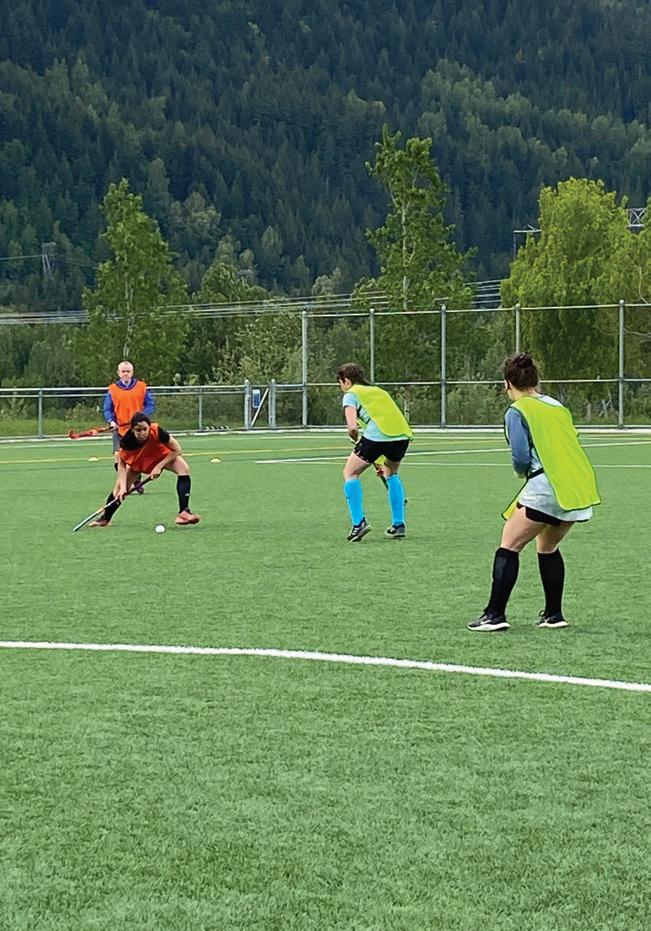
For now, WFHC is getting ready to offer its upcoming indoor winter sessions, which will take place on Monday nights from Jan. 9 to April 3. Unlike last year, Spring Creek Community School will be the venue, with both kids and adults welcome. Visit the club’s website for more details. ■

WHAT ELSE IS the Christmas holly/daze season if not a time of ritual? Everything from whipping up a Christmas cake from grandma’s old recipe to creating your own new rituals— taking time to contemplate, lighting a special candle, knocking on a lonely neighbour’s door with a slice of that still-warm cake.
I’m betting you don’t really need that black crab cookware set or fifth wooly sweater on your Christmas list just because it has a nicer collar. So without further ado, here are some fresh gift ideas for my annual “gifts that
BY GLENDA BARTOSHdisappear”—things that use few resources from our already beleaguered planet and won’t end up in the landfill.
This year, though, I’m not suggesting any hard goods, even ones you can eat! Instead, let’s go whole-hog—or is that whole-turkey?— for gifts that really keep on giving, and giving…
Most of us have so much, while so many people and worthwhile efforts in Sea to Sky and beyond operate with so little, that I can’t think of a better new ritual than sitting down and thinking about which ones best connect with the people on your list in a meaningful way.
Once you choose, you can make a wee gift
card, or some agencies offer e-cards, to tell your lovely giftee they’ve made a delightfully positive difference during this season of hope and kindness. Bonus—your donation, no matter how small, can open people’s eyes and hearts to a new worthwhile cause, and grow the concept of passing it forward by doing the same for the people they want to give to.
Merry wishes for a happy holiday and Christmas, however you spend it.
It feels counterintuitive that a place as seemingly high-end and built for fun and frivolity as Whistler actually has one of B.C.’s fastest-growing food banks. But it’s true. The huge increase in demand for Whistler’s food bank—now with five times more monthly visitors than before the pandemic, plus the subsequent five-fold increase in budget—has been well-described in Pique and CBC News.
According to Food Banks Canada, there’s been a 25-per-cent increase in demand for B.C.’s food banks from last year to this, while the national increase has been about 15 per cent. In short, it’s the most challenging year ever for Canadian food banks.
Pemberton opened its new food bank location this fall, while Squamish has had one for years. Young people, old people, single dads, single moms, families, new Canadians— the need is zooming off the charts as prices for food and rent do the same.
(where I’ve volunteered many an hour over the years), and designate whichever one you want.
For good reason WAG—Whistler Animals Galore—has been voted Whistler’s favourite non-profit six years in a row. Something about our fine furry friends in need tugs at our heartstrings, and WAG staff and volunteers are so caring, they can’t be beat. This is WAG’s 40th year in operation—can ya believe it!?—so they’re hoping to raise $40,000. Good news: Every dollar donated in December will be matched by WAG’s best friends, Moguls Coffee House and Zog’s Whistler.
You and your giftees can also be best friends—to Whistler’s artists, musicians and all the folks who help build the arts and culture scene here.
Arts Whistler, which holds a special place in my heart, is also celebrating its 40th this year. Buy that culture vulture on your list an Arts Whistler membership, or simply make a donation in their name. Same goes for the Whistler Film Festival—”Canada’s coolest film fest!”—and the Whistler Writers Festival. Whistler wouldn’t be Whistler without any of these brilliant not-for-profit organizations that add a richness to the community way beyond wealth.
of work in the direst of circumstances, you’ll easily find one that beautifully dovetails with your giftees’ values and interests. Here are a few I especially like…
World Bicycle Relief is a great cause that gets much-needed Buffalo bikes into the hands of African girls. It’s championed by longtime friends of Whistler, Bob Wyckham and Stan Greenfield. Along similar lines is Bicycles for Humanity, started years ago by Whistlerites—the late Pat Montani and his wife, Brenda. Both programs deliver muchneeded bikes to developing countries around the world.
Another favourite is Orangutan Foundation International Canada. Based in Vancouver and founded by SFU professor and one of my heroes, Biruté Galdikas, OFI operates an effective refuge in Borneo for hundreds of orangutans orphaned or debilitated, often due to those monstrous palm oil plantations I’ve written about.
I only know about OFI because one Christmas years ago I was “given” a young orangutan, Gil, that hubby adopted in my name. Besides the impressive work OFI does, I love their personal touch, including all the photos and cool details I get, like how Gil enjoys eating the sweet inner bark of acacia branches. Today, I was so happy to hear that Gil, who was taken in with a broken arm, is ready to be released into the wild.
Now there’s a gift that’s kept on giving, on so many levels.
ACT Here are some gift ideas that use few resources and won’t end up in the landfill.
BY VERA LIVCHAK / GETTY IMAGESAny donation you make in someone else’s name—or your own!—will give and give again. You can spread the joy directly using each Sea to Sky food bank’s website, or via CBC’s annual B.C. food bank drive
If you want to spread your giving wings beyond the corridor, there are so many worthwhile organizations doing the hardest
Glenda Bartosh is an award-winning journalist who reminds you that the war in Ukraine rages on, and the Ukrainian Canadian Congress is one of the best ways to get much-needed funds there. n
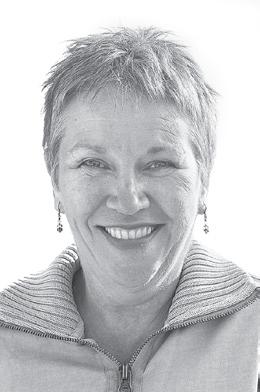
Spin 6:15-7:15 p.m. Courtney
F Spin 6-7 p.m. Courtney
Spin FRIDAY DEC 9 | 6 PM AGES 13-18 (GRADE 8+)


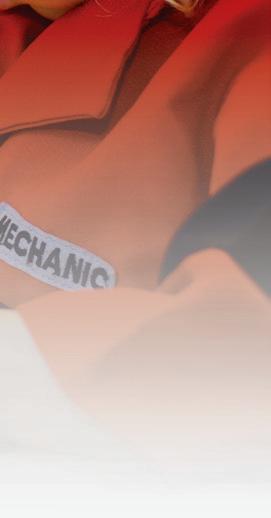










p.m. Alex whistleryouthcentre.com 604.935.8187 • WhistlerYouthCentre
F whistleryouthcentre.com 604.935.8187 • WhistlerYouthCentre






6-7 p.m. Courtney THE YC ANNUAL Swing by the YC for the best Turkey Dinner in town prepared by the chefs at The Faimont Chateau! Get your holiday cheer on with FREE gifts from WCSS! 4335 Blackomb Way (basement of the Arts Whistler building) sponsored by...


I Zumba 6:30-7:30 p.m. Carmen



 BY ALYSSA NOEL
BY ALYSSA NOEL
WHEN IRA PETTLE turned up at Norman Foote’s house for their first co-writing session, he came with a binder full of song ideas and a lifelong dream.
Pettle might be well-known around Whistler as DJ Ira—performing for kids and leading them in workshops and at events—but for more than 30 years, he has also harboured a dream of releasing an album filled with original music.
“It really begins with me as a kid, having this dream to create original music,” Pettle says. “My life unfolding in parallel with that kind of performance art, but not quite. I always carry that. I’m just one step off my dream … Fast-forward all these years later, still thinking about it, still writing lyrics and coming up with song ideas and melodies and writing them all down, keeping this secret log of creative passion, just continuing to roll out. Thirty five years later, the pandemic hits.”
That time offered a pause and a break from Pettle’s multiple projects, and he decided to look at that music again.
While he had some experience with music as a DJ and performer, he realized it might
be wise to turn to an expert for help. So, he reached out to Foote, a Juno-nominated veteran children’s performer. Foote listened to his songs and agreed to help.
“I had a lot of respect for him as an entertainer and his ability to work with kids and older crowds as well,” Foote says. “I had respect there. I didn’t know what to expect when I heard his music and then when I heard
of my music, my passion, for, like, 30 years on my own,” he says. “So I’m very much a solo act. Bridging that gap and taking on a partner was very difficult. It was very integral for me—and this was a practice I did early on—to say yes to his suggestions, to really try on what he was saying rather than come back with my protective, creative disagreement. I just had to constantly remind myself to try it on.”
and coming back new, a new skin, or Chapter 2, Act 2, Ira 2.0,” he says. “It’s almost like a calling, and it’s all unfolding now.”
To help support the self-funded venture (which included everything from studio time to hiring musicians), Pettle has launched a Kickstarter campaign in the hopes of raising $54,000. That crowd-funding campaign is allor-nothing, meaning if he doesn’t reach his goal by Jan. 3, he won’t receive any of the donations.
The primary reason he chose the platform because it’s largely used for creative endeavours, but also “I’ve always been up for the challenge,” he says.
“Then there’s a faith in my community, my world, my dream. My vision for what this is says, ‘raising $54,000 is actually not going to be a problem at all.’”
- IRA PETTLEit—they were songs that were being sketched out, some needed completion, but the bones were started.”
For the first of many writing sessions, Pettle brought about 20 song ideas to pitch and Foote was drawn to a selection of them.
“We were meeting up a couple times a week to just work the tunes and we were fleshing them out for a bunch of months before we went to the studio,” Pettle says.
When Foote told him it was time to record, he was a little taken aback.
“The struggle is, I’ve been doing a version
With so much experience in the music industry, Foote was also able to suggest two producers—Bill Buckingham and Andreas Schuld—as well as musicians for different songs.
In the end, the album, A Little Bit, is a collection of 10 songs that hop from pop to rock to ballad and back again, geared towards both children and adults.
“We did a lot of experimenting,” Foote says. “I’m very proud of the material.”
For Pettle, everything that comes next is nerve-racking but exciting.
“It’s kind of like shedding an old skin
On top of the campaign, he’s set to host an album release party on Dec. 30 from 7 to 8 p.m. at the Whistler Conference Centre. (Tickets are by donation at eventbrite.ca/e/ira-pettlealbum-release-concert-tickets-479492323447.)
Then, in 2023, he hopes to tour the new record and produce videos for it.
It might technically be a children’s album, but Pettle hopes it appeals to people of all ages.
“There are extremely deep-level messages in every song, and heart and soul in every song,” he says. “There’s morality, my morality at the time in every song. So that speaks to whoever hears it as that.”
To donate to the Kickstarter campaign, visit kickstarter.com/projects/irapettle/irapettle-a-little-bit/description. n
THE MAGIC of TrailerHawk just might be the band’s organic origin story.

After playing in various well-known Canadian bands (Matthew Good, Sons of Freedom), the collective of Vancouver musicians had all but stepped away from the stage back in 2016 when they decided it would be fun to play some classic country covers— think Johnny Cash and Hank Williams.
It turned out to be more than just fun, so they kept going.
“When we got together as TrailerHawk, it opened the floodgate,” says singer Carmen Bruno. “As soon as we started playing together, we started with a couple covers, but immediately we were just coming up with [original music]. We were like, ‘This is it. This is how it’s supposed to be.’”
Building momentum with their rock ‘n’ roll-tinged Americana, they released their first full-length record, 12 Tracks & Roadmaps, in—dun dun dun—2020.
“We were just getting ready to go out on the road with Blackberry Smoke, which was a big deal to us,” says guitarist Rod Bruno (husband of Carmen). “We were on the phone firming that up and the other call came in that everyone was off the road.”
Despite being their first, the record marked several major wins for the group.
First, they landed Canadian producer (and musician) Colin Linden, who worked on the country music drama Nashville as the musical director.
“Colin really believed in the songs and thought they were something he’d like to share with [musicians on the show],” Carmen says.
Funnily enough, Carmen and Rod had been Nashville fans since before TrailerHawk was even a twinkle in their eyes.
“Carmen was like, ‘We have to watch Nashville,’” Rod remembers. “I was like, ‘Oh it’s a soap-opera chick show.’ After one episode we were compromising sleep to watch more.”
Fast-forward a year later, and Deacon Claybourne—also known as the actor and musician Charles Esten—was lending his vocals to their track “Church of Jim Beam.”
“He chose that song and was quite insistent on singing it,” Rod adds.
So, it’s no stretch to say that with this record in the bag and a promotional tour planned, the band—which, at the time, was also made up of drummer Don Short, pedal-steel player Lanny Hussey and bassist Don Binns—was disappointed to watch the pandemic quash the plan.
“It was disappointing in the moment, but we believed so much in that album that we did our best,” Carmen says.
After the challenges of that time, Short and Hussey decided to step back from playing live music, leaving Carmen and Rod to replace them.
Now, they’re set to hit the road again with Gord Robert on drums and Tom Hammel on pedal steel and acoustic guitar.
As for Binns, well, he might be one of the more determined musicians around.
“We’re all ready to come and play for you guys [in Whistler], but Don somehow had an X-Acto knife in his pocket and he accidentally severed his finger and tendons,” Rod says. “He’s in a full cast. We thought about cancelling, but that’s not in our vocabulary. I said, ‘What about a bass synth with your picking hand?’ He said, ‘Yeah’ and that’s what’s happening. It’s becoming Spinal Tap.”
But the show must go on, and for TrailerHawk that means “full steam ahead.”
“[Whistler] has been on our bucket list for a long time,” Rod adds. “Then Donny cut his hand off and now we’re a dance band.”
But don’t worry, the show was never in real peril.
“He would literally have to be dead to not play,” Carmen says.
Catch the most dedicated rock band in Vancouver as part of Arts Whistler Live! At the Maury Young Arts Centre on Dec. 10.

Tickets are $25 at showpass.com/aw-livetrailerhawk. n

 HAWK ROCK Vancouver’s TrailerHawk are set to make their Whistler debut at the Maury Young Arts Centre on Dec. 10.
HAWK ROCK Vancouver’s TrailerHawk are set to make their Whistler debut at the Maury Young Arts Centre on Dec. 10.
Come watch the fastest athletes on ice slide into Whistler, Dec. 9 and 10, for the Eberspächer Luge World Cup and the Eberspächer Team Relay World Cup presented by BMW.



The Whistler Sliding Centre will play host to the second stop on the World Cup luge circuit as more than 100 athletes, representing more than 20 countries, blast down the Olympic Track at speeds up to 130 km/h in men and women singles, mens and womens doubles and team relay races.


In this sport every thousandth of a second counts, and the fastest to the bottom wins. Come Cheer on Canada as we keep #ChasingFast!
> Dec. 9 and 10
> Tickets $10 at the gate
> Sliding schedule subject to change. Find more info at luge.ca/wcw2022
Jeanette
Choir leads everyone in some holiday favourites and then works with the audience as a group to learn a version of a bonafide holiday classic—including harmonies! Entry by donation. All cash and digital donations support the Whistler Food Bank.
> Dec. 9, 7 p.m.
> Maury Young Arts Centre
> By donation
Stick a pin in a map somewhere between the California hills, Motor City, and Nashville and there you’ll find
TrailerHawk blasting out haunted melodies atop country-soaked Americana rock n’ roll. Singing tales of life, liquor, and love on the run, lead singer Carmen Bruno’s powerhouse vocals are joined by a lineup of all-star musicians and former band members of Sons of Freedom, The Grapes of Wrath, and Matthew Good.
> Dec. 10, 7 to 10 p.m.


> Maury Young Arts Centre


> $25

Kick off your boots and join the Audain Art Museum for a post-mountain evening of food, drinks and art. After mingling with friends and enjoying snacks from Picnic Whistler, guests have the opportunity to revel in the works of Out of Control: The Concrete Art of Skateboarding. This

 THE AWARD-WINNING ANIMATOR, PRODUCER AND DIRECTOR WAS IN TOWN FOR THE WHISTLER FILM FESTIVAL
THE AWARD-WINNING ANIMATOR, PRODUCER AND DIRECTOR WAS IN TOWN FOR THE WHISTLER FILM FESTIVAL



 BY BRANDON BARRETT
BY BRANDON BARRETT

THE FIRST HINT of the cultural juggernaut The Simpsons would eventually become came early for animator, producer and director, David Silverman.
The Maryland native was back home for the holidays in December 1989, just days after the series premiered with its Christmas special, “Simpsons Roasting on an Open Fire,” the first of 73 episodes—and counting—he would direct, and long before Bart and his dysfunctional family became a fixture of the American zeitgeist. Sporting a crew jacket emblazoned with his name on the front and the show logo based off one of his drawings on the back, Silverman kept getting hounded by fans asking him where they could pick one up for themselves.
“There’s no merchandising of The Simpsons at this point. There weren’t all these T-shirts or anything—there was nothing,” recalls Silverman, who was in the resort last week for the Whistler Film Festival. “I thought to myself, ‘What is going on here?’ I’m just walking around with this one jacket and I’m getting a lot more attention than I normally would.
“That’s when I realized we were onto something.”
Not that Silverman had much time to




enjoy the fruits of his labour. Especially in those early days, he and the rest of the animation team barely had a spare moment to sleep, let alone take notice of the cultural phenomenon they had created. And, outside of show creator and executive producer Matt Groening, there’s a strong argument to be made that nobody has had more direct influence on the show than Silverman himself, who has directed a significant number of the show’s most iconic episodes, and is largely credited with creating most of the rules for drawing The Simpsons, having been involved since The Tracey Ullman Show days.
“On The Tracey Ullman Show, it was primarily myself and Wes Archer doing the animation and we literally didn’t have the time to make model sheets. We’re looking over each other’s shoulder and just drawing it,” Silverman explains. “It was sort of reverse engineered, trying to analyze how to construct these characters for people who don’t know how to draw them yet or animators who are not familiar with them. Because they weren’t traditional Disney-style characters, or traditional Hanna-Barbera-style characters. They were Matt Groening-style characters as interpreted by Wes Anderson and me.”
It begs a question Silverman has heard before: why yellow?

“Oh, well, I can answer that very simply. I have always thought that, basically, Bart, Lisa
and Maggie do not have a hairline … Flesh colour wouldn’t work because what happens with the hair? I can’t do a slow fade and I don’t want to add a hairline because that would destroy the graphic integrity. So yellow worked as a hair and skin colour,” he says. “And Matt [Groening] liked it because he thought as people were flipping through channels and … these yellow characters showed up, they’d be like, ‘Hey, this is weird. I’m gonna watch this.’”

Thirty-four seasons in, The Simpsons’ longevity is unparalleled (“It’s an ongoing
mystery to us,” Silverman quips). But, of course, after three-and-a-half decades, Silverman is no stranger to the common refrain often heard from Simpsons nostalgists: that the more recent output can’t shake a sprinkled doughnut at the show’s golden years (generally considered to be Seasons 3 through 8, give or take a season or two).


“Eventually things have to change. You can’t keep maintaining what it was like in the so-called good old days because the show’s evolving,” he says. “And yes, there are ebbs and flows, but I think the show is as great as it always has been. It’s just different. You have to look at it differently. You can’t look at it as it was back then, because we were inventing characters. And in a way, we were inventing a style of TV animation for prime time that hadn’t been seen yet. So, of course, it’s going to have a different context.
“And by the way, there are as many people saying they miss the good old days and many people who are younger that say they can’t stand the older ones, [the animation] is too crude for them. Hey, you know what? They’re both right.”


Silverman was at the Whistler Film Festival last week to lead two separate workshops. While the festival officially wrapped its in-person portion on Sunday, Dec. 4, films are still available to stream online until Jan. 2. Learn more at whistlerfilmfestival.com. ■

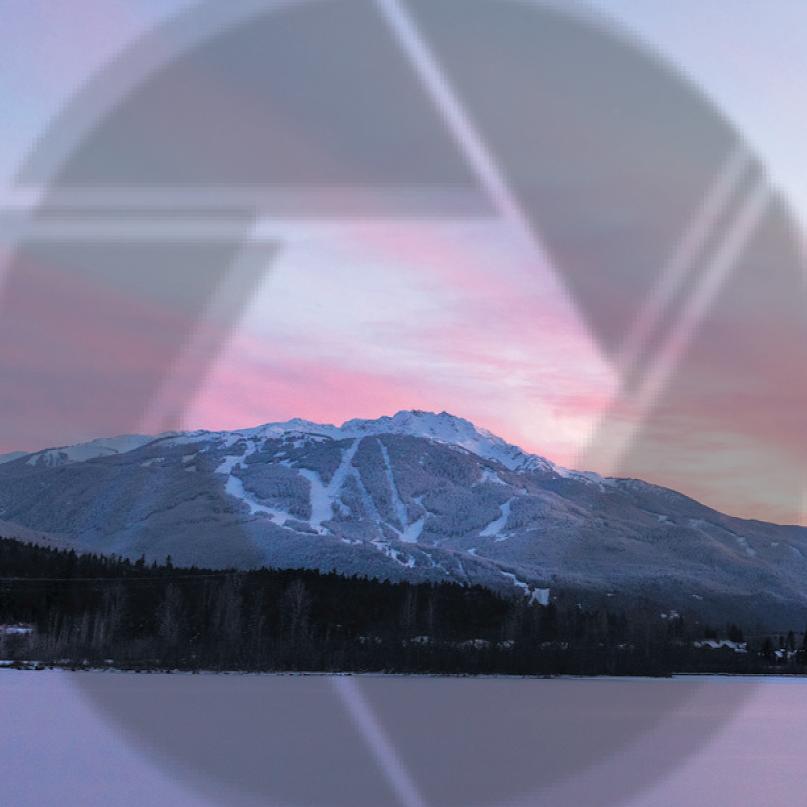

Whistler Village Suites recognizes this has been a challenging year for many. We are so fortunate to live in a generous community and have our tourism partners pull together to help raise funds for two meaningful charities We would like to thank everyone who supported the event and our sponsors who helped make it possible, namely:

21 Steps Kitchen + Bar
3 Singing Birds
Audain Art Museum

Backcountry Brewing
BC Ferries
Black Rock Oceanfront Resort

Canucks Sports & Entertainment
Caramba! Restaurant
Coast Mountain Brewing
Cool As A Moose
Cori Ross
CRANKED Espresso Bar
Crepe Montagne
Crystal Lodge
Delta Hotels by Marr ott Grand Okanagan Resort
Delta Hotels by Marr ott Vancouver Downtown Suites

Delta Hotels by Marr ott Victoria Ocean Point
Earls Whistler Vi lage
Fairmont Chateau Whistler
Gibbons Whistler
Hatley
Hilton Whist er Resort & Spa
Hunter Gather
JW Marriott Edmonton Ice District
JW Marriott Tucson Starr Pass Resort & Spa
K BRO Linen Systems

Long Beach Lodge Resort
Marriott Vancouver Airport

Metropolitan Hotel Vancouver
Nesters Market
Nicklaus North Whist er Nonna Pia’s
Pan Pacific Whistler Village Centre
Pipeline Plumbing & Heating
purebread
Re/Max Sea to Sky Real Estate
Scandinave Spa Whistler
Sea To Sky Gondola
Serta Simmons Bedding
Slopeside Supply
Squamish Lil wat Cultural Centre

Sun Peaks Grand Hotel & conference Centre
Superfly Ziplines
The DOULAS, Autograph Collection
The Marriott Calgary Downtown
The Nook of the North
The Spa at Whistler
The Trad ng Post
The Westin Bayshore, Vancouver
The Westin Calgary
The Westin Maui Resort & Spa
Vancouver Marriott Pinnacle Downtown
Westin Resort & Spa, Whistler
WHISLIFE Whistler Blackcomb
Whistler Film Festival
Whistler Golf Course
Whistler Half Marathon Whistler Sports Legacies

Whistler Wine Merchants
Whistler Zip Trek Whistler com Whoola Toys Yogacara Whistler
WHEN WHISTLER Mountain opened to visitors in 1966, Franz Wilhelmsen was certain people would bring their own lunch and would not want to purchase food on the mountain. Originally, the only place on the hill to purchase food was Garibaldi Cafeteria near the gondola base on Whistler Mountain (now Creekside).
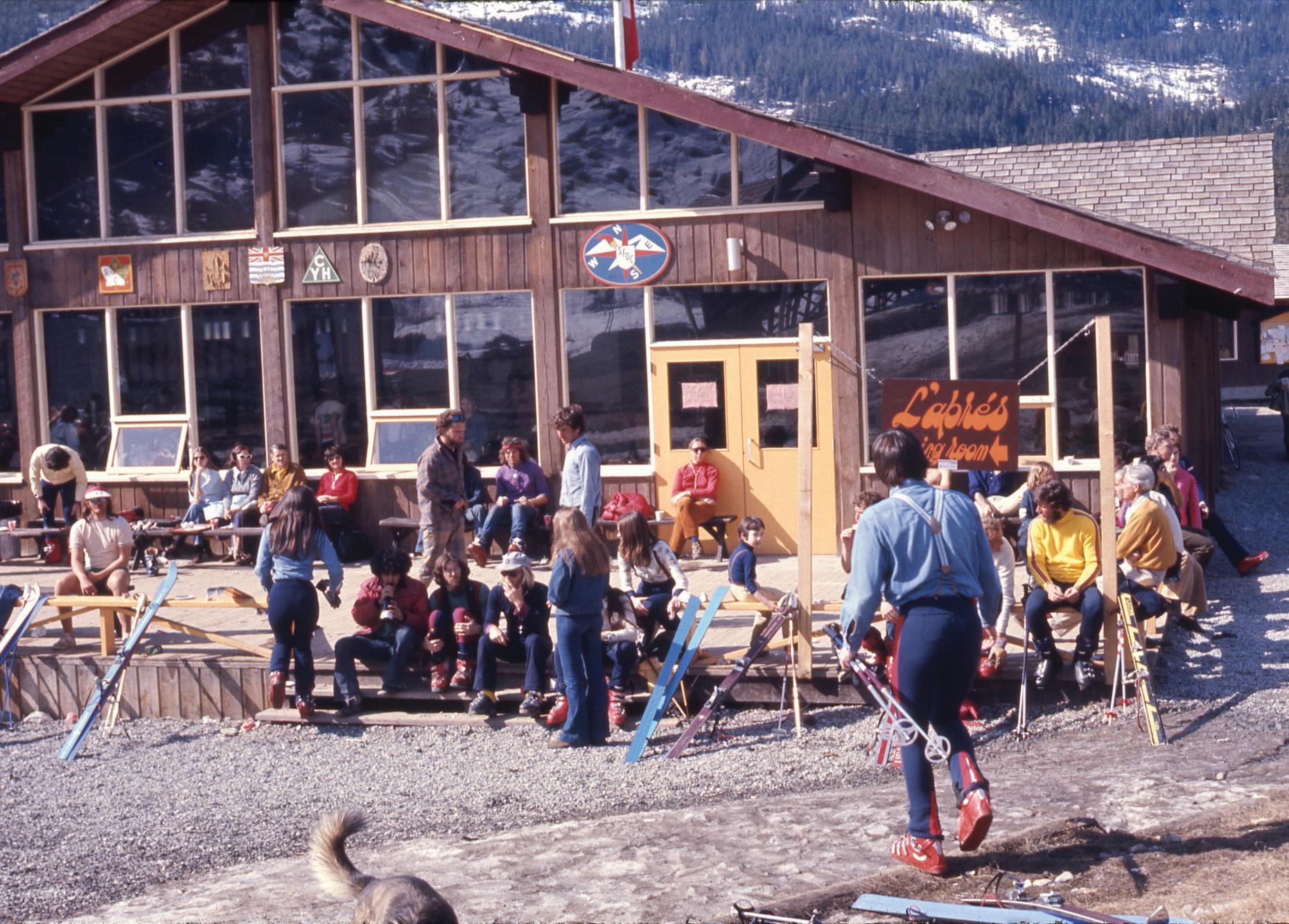
The cafeteria first opened during construction of the lifts in 1965 to feed the influx of workers. Run by Leo and Soula Katsuris, the cafeteria was nothing fancy, but it fed everyone quickly with limited resources. Once the lifts opened for visitors, the cafeteria transitioned to feeding skiers.
Garibaldi Cafeteria, often known as Whistler Cafeteria or simply “the cafeteria,” quickly became a community hub and remained in operation for more than 15 years. Many of the original members of the volunteer ski patrol remember sleeping in the cafeteria when accommodation was tight. Weekly movie nights also moved to the cafeteria once it opened. This social night was so popular that locals from all around the valley would gather weekly to watch films. Tragically, in the early 1970s, the cafeteria was also home to Whistler’s first recorded murder, when a 20-year-old employee was shot and killed in a random attack.
In 1969, Leo Katsuris opened L’Après next to the cafeteria. Open from lunch until late, L’Après catered to a later crowd with pizza, Greek food and regular live music and parties, becoming Le Club in the evenings. The theme nights, including Beach Party and Western Night, were legendary. Eventually, the Garibaldi Cafeteria was incorporated into the L’Après brand, becoming L’Après Dining Room and Cafeteria, the centre of everything in Whistler at the time. The B.C. liquor board required diners to purchase food in order to buy a drink, and nursing a “plastic cheese sandwich” kept the beer flowing.
Further up the mountain, the hungry skier market was capitalized on almost immediately when (William) Jack BigginPound from Squamish set up a Coleman camp stove and picnic table to serve soup, sandwiches and hot drinks, as well as Mary’s famous cinnamon buns, in the Red Shack at the top of Red Chair. This moved to the Roundhouse after it was built in the summer of 1966 without any dining facilities.
The Katsuris’, who, along with their staff, were known colloquially as ‘The Greeks,” also managed the dining at the Roundhouse, where everything had to be brought up the mountain pre-prepared. There was no power, storage or refrigeration until 1970, when renovations to the Roundhouse brought “a new modern electric food preparation and serving area.” This allowed a larger variety and amount of food to be prepared and served, including hot chocolate, fries, chili, stew, hot dogs and chicken. They also started serving breakfast on the mountain for the first time.
Trying to predict demand was a real guessing game, based largely on the weather. Despite the new facilities, challenges in food preparation and logistics continued, and there were very few updates to the food service on Whistler Mountain over the next 10 years. Before long, the food service gained a poor reputation. According to one story, when the wait time for food at the Roundhouse was long, hamburger patties were only cooked on one side to speed up the cook time. Bob Penner, who lived in Whistler in the 1970s, said the hamburgers at the Roundhouse “made your regular canned meat or tuna taste so much better.”
Once the development of Blackcomb Mountain was announced, the top brass at Whistler Mountain knew they needed to step up their hospitality game. Whistler Mountain Ski Corp took over the existing food venues, redeveloping L’Après into Dusty’s, and, thanks to the competition with Blackcomb, the next decade brought many new and improved on-mountain dining options. n









ARIES (March 21-April 19): Aries filmmaker Andrei Tarkovsky wrote, “To be free, you simply have to be so, without asking permission. You must have your own hypothesis about what you are called to do, and follow it, not giving in to circumstances or complying with them. But that sort of freedom demands powerful inner resources, a high degree of self-awareness, and a consciousness of your responsibility to yourself and therefore to other people.” That last element is where some freedom-seekers falter. They neglect their obligation to care for and serve their fellow humans. I want to make sure you don’t do that, Aries, as you launch a new phase of your liberation process. Authentic freedom is conscientious.
TAURUS (April 20-May 20): The term “neurodiversity” refers to the fact that the human brain functions in a wide variety of ways. There are not just a few versions of mental health and learning styles that are better than all the others. Taurus musician David Byrne believes he is neurodiverse because he is on the autism spectrum. That’s an advantage, he feels, giving him the power to focus with extra intensity on his creative pursuits. I consider myself neurodiverse because my life in the imaginal realm is just as important to me as my life in the material world. I suspect that most of us are neurodiverse in some sense— deviating from “normal” mental functioning. What about you, Taurus? The coming months will be an excellent time to explore and celebrate your own neurodiversity.
GEMINI (May 21-June 20): Poet Jane Hirshfield says that Zen Buddhism is built on three principles: 1. Everything changes. 2. Everything is connected. 3. Pay attention. Even if you are not a Zen practitioner, Gemini, I hope you will focus on the last two precepts in the coming weeks. If I had to summarize the formula that will bring you the most interesting experiences and feelings, it would be, “Pay attention to how everything is connected.” I hope you will intensify your intention to see how all the apparent fragments are interwoven. Here’s my secret agenda: I think it will help you register the truth that your life has a higher purpose than you’re usually aware of—and that the whole world is conspiring to help you fulfil that purpose.
CANCER (June 21-July 22): Author Flannery O’Connor wrote, “You have to cherish the world at the same time that you struggle to endure it.” I will add a further thought: “You have to cherish the world at the same time that you struggle to endure it and strive to transform it into a better place.” Let’s make this one of your inspirational meditations in the coming months, Cancerian. I suspect you will have more power than usual to transform the world into a better place. Get started! (PS: Doing so will enhance your ability to endure and cherish.)
LEO (July 23-Aug. 22): Many sports journalists will tell you that while they may root for their favourite teams, they also “root for the story.” They want a compelling tale to tell. They yearn for dramatic plot twists that reveal entertaining details about interesting characters performing unique feats. That’s how I’m going to be in the coming months Leo, at least in relation to you. I hope to see you engaged in epic sagas, creating yourself with verve as you weave your way through fun challenges and intriguing adventures. I predict my hope will be realized.
VIRGO (Aug. 23-Sept. 22): Venus is too hot and dry for humans to live on. But if travellers from Earth could figure out a way to feel comfortable there, they would enjoy a marvellous perk. The planet rotates very slowly. One complete day and night lasts for 243 Earth days and nights. That means you and a special friend could take a romantic stroll toward the sunset for as long as you wanted, and never see the sun go down. I invite you to dream up equally lyrical adventures in togetherness here on Earth during the coming months, Virgo. Your intimate
alliances will thrive as you get imaginative and creative about nurturing togetherness.
LIBRA (Sept. 23-Oct. 22): As far as I’m concerned, Libran Buddhist monk and author Thích Nhat Hanh was one of the finest humans who ever lived. “Where do you seek the spiritual?” he asked. His answer: “You seek the spiritual in every ordinary thing that you do every day. Sweeping the floor, watering the vegetables, and washing the dishes become sacred if mindfulness is there.” In the coming weeks, Libra, you will have exceptional power to live like this: to regard every event, however mundane or routine, as an opportunity to express your soulful love and gratitude for the privilege of being alive. Act as if the whole world is your precious sanctuary.
SCORPIO (Oct. 23-Nov. 21): A reader named Elisa Jean tells me, “We Scorpio allies admire how Scorpios can be so solicitous and welcoming: the best party hosts. They know how to foster social situations that bring out the best in everyone and provide convivial entertainment. Yet Scorpios also know everyone’s secrets. They are connoisseurs of the skeletons in the closets. So they have the power to spawn discordant commotions and wreak havoc on people’s reputations. But they rarely do. Instead, they keep the secrets. They use their covert knowledge to weave deep connections.” Everything Ella Jean described will be your specialties in the coming weeks, Scorpio.
SAGITTARIUS (Nov. 22-Dec. 21): Of all the signs in the zodiac, you Sagittarians are least likely to stay in one location for extended periods. Many of you enjoy the need to move around from place to place. Doing so may be crucial in satisfying your quest for ever-fresh knowledge and stimulation. You understand that it’s risky to get too fixed in your habits and too dogmatic in your beliefs. So you feel an imperative to keep disrupting routines before they become deadening. When you are successful in this endeavour, it’s often due to a special talent you have: your capacity for creating an inner sense of home that enables you to feel stable and grounded as you ramble free. I believe this superpower will be extra strong during the coming months.
CAPRICORN (Dec. 22-Jan. 19): Capricorn author Edgar Allan Poe made this mysterious statement: “We can, at any time, double the true beauty of an actual landscape by half closing our eyes as we look at it.” What did he mean? He was referring to how crucial it is to see life “through the veil of the soul.” Merely using our physical vision gives us only half the story. To be receptive to the full glory of the world, our deepest self must also participate in the vision. Of course, this is always true. But it’s even more extra especially true than usual for you right now.
AQUARIUS (Jan. 20-Feb. 18): Aquarian theologian Henri Nouwen wrote, “I have discovered that the gifts of life are often hidden in the places that hurt most.” Yikes! Really? I don’t like that idea. But I will say this: If Nouwen’s theory has a grain of truth, you will capitalize on that fact in the coming weeks. Amazingly enough, a wound or pain you experienced in the past could reveal a redemptive possibility that inspires and heals you.
PISCES (Feb. 19-March 20): Piscean novelist Viet Thanh Nguyen says it’s wise to talk to yourself. No other conversational partner is more fascinating. No one else listens as well. I offer you his advice in the hope of encouraging you to upgrade the intensity and frequency of your dialogues with yourself. It’s an excellent astrological time to go deeper with the questions you pose and to be braver in formulating your responses. Make the coming weeks be the time when you find out much more about what you truly think and feel.
Homework: What action could you take to rouse unexpected joy in a person you care about? Newsletter. FreeWillAstrology.com.

In addition to this column, Rob Brezsny creates
In-depth weekly forecasts designed to inspire and uplift you. To buy access, phone 1-888-499-4425. Once you’ve chosen the Block of Time you like, call 1-888-682-8777 to hear Rob’s forecasts. www.freewillastrology.com
5.44 ACRE Lot 51, Ivey Lake Subdivision, $650,000, 2-minute walk to Lake. 2.3 Km northeast of Pemberton, a 30-minute drive to Whistler. Fantastic view of Mt Currie. 604-744-8816 owen.hairsine@gmail.com




RE-USE-IT CENTRE Donations daily 10 am to 4 pm Accepting pre-loved clothing, gear and household items. Shopping daily 10 am to 6 pm 8000 Nesters Road 604-932-1121



RE-BUILD-IT CENTRE Donations daily 10 am to 5 pm Accepting pre-loved furniture, tools and building supplies Shopping daily 10 am to 5 pm 1003 Lynham Road 604-932-1125 Visit mywcss.org and our social channels for updates.











Looking to contribute to your local community? Consider a career in local government. Join the SLRD’s team of dedicated staff who work together to make a difference in the region. Headquartered in Pemberton, the Squamish-Lillooet Regional District (SLRD) delivers a wide range of regional, sub-regional and local services to its residents. The SLRD is a BC Regional District consisting of four member municipalities (Squamish, Whistler, Pemberton, Lillooet) and four electoral areas. Services include land use planning, solid waste management, building inspection, fire protection, emergency preparedness, 911 services, recreation, water and sewer utilities, regional transit, trails and open spaces as well as financial support for various community services.



The region contains some of the most spectacular forests, waterways, and mountains in the province and affords an endless range of opportunities for outdoor adventure, making it an exceptional place to live, work and play.




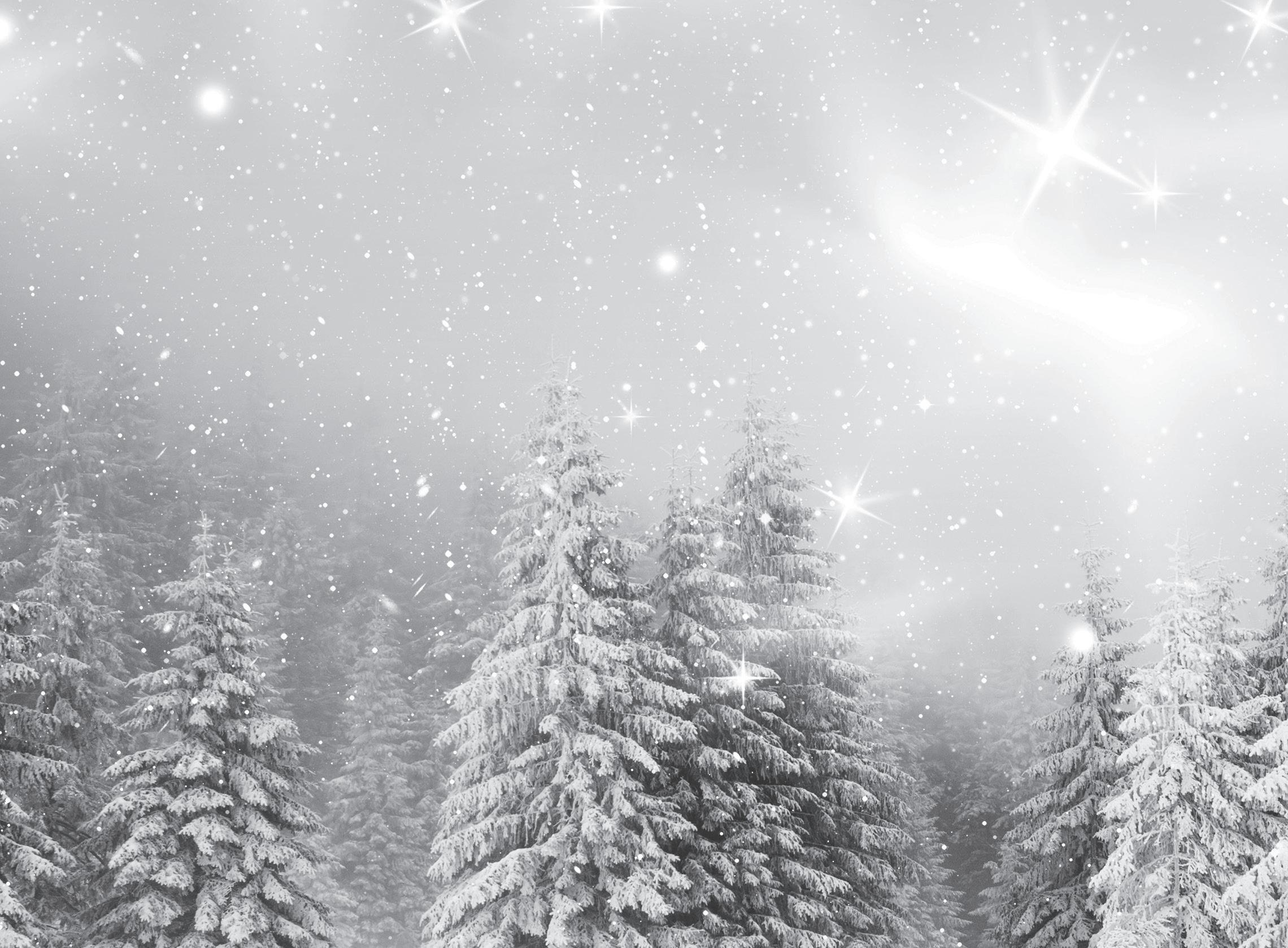
The SLRD is seeking an experienced leader to fill the position of Director of Environmental Services. Reporting to the Chief Administrative Officer (CAO), and as a member of the senior leadership team, the Director of Environmental Services is responsible for the strategic oversight of the SLRD’s services including water systems, sewer systems, solid waste management, street lighting systems, flood and debris flow structures, parks and trails development and services, building and facility management, and capital infrastructure projects for the electoral areas of the Regional District. This position is also responsible for short and long-term capital planning including asset management planning, dyking inspections, and bylaw and contract administration for the department.
The ideal candidate will have 7 years of recent related experience overseeing capital infrastructure projects, utilities, solid waste management, parks and trails, or facilities in a local government or corporate setting, and post secondary degree or diploma in Civil Engineering, Applied Science Technology or related discipline. For further information, please refer to the full job description at www.slrd.bc.ca/employment

Salary will be determined commensurate with experience. This position also offers a comprehensive benefits package, participation in the Municipal Pension Plan, a compressed work week (9-day fortnight) and flexible work from home opportunities.
Interested candidates are invited to submit their cover letter and resume (preferably in pdf format) by email to careers@slrd.bc.ca. This posting will remain open until filled, with application review commencing on January 3, 2023.
We sincerely thank all applicants for their interest, however, only those shortlisted will be contacted.

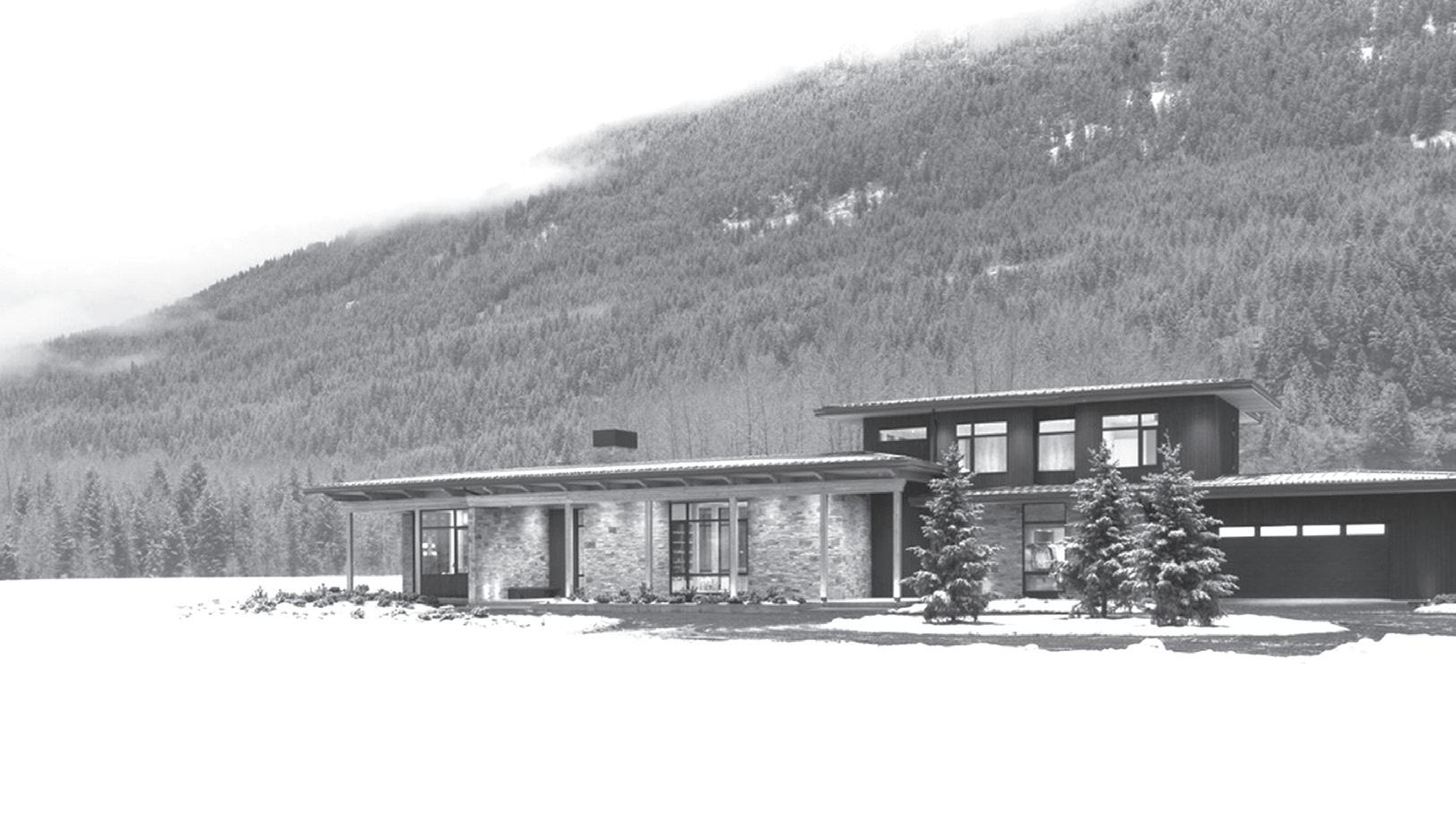






We are currently hiring the following positions for projects in WHISTLER.


Journeymen Carpenters (5+ years)
Journeymen Carpenters (5+ years)
Skilled Labourers
Skilled Labourers
We offer competitive pay, a benefits package, company cell phone plan, interesting projects, a collaborative team environment, and a chance to improve your existing skills.
We are looking for dedicated team players who want to join a rapidly growing company and establish a long-term career in construction.

Please forward your resume to Lea@gccltd.ca
Join a Dynamic Team of Art Lovers!

The Museum is currently seeking: Assist the Director & Chief Curator, as well as the Curator, in the research, development and presentation of Permanent Collection displays and Special Exhibitions.

• Permanent, Full-Time
• Competitive Salary
• Benefit Program
For complete job descriptions and to apply visit audainartmuseum.com/employment
Or email applications to bbeacom@audainartmuseum.com


•
•
•

and Dental Benefits
• Positive Work Environment

If you love what you do and have a desire to work on architecturally-beautiful and sophisticated custom homes while growing your career with a renowned Whistler builder, please get in touch. You can send your resume to info@evrfinehomes.com and can view our work at www.evrfinehomes.com.

We look forward to hearing from you!


Vacasa’s forward-thinking approach and industry-leading technology help set us apart as the largest full-service vacation rental company in North America. We are seeking individuals with a passion for providing

Free On Site Staff Parking
Free Staff Meals



Tuition Reimbursement Program
Retirement Savings Program 50% Discount in our Food & Beverage outlets

Team Member Travel Discount (including Friends & Family Benefits)
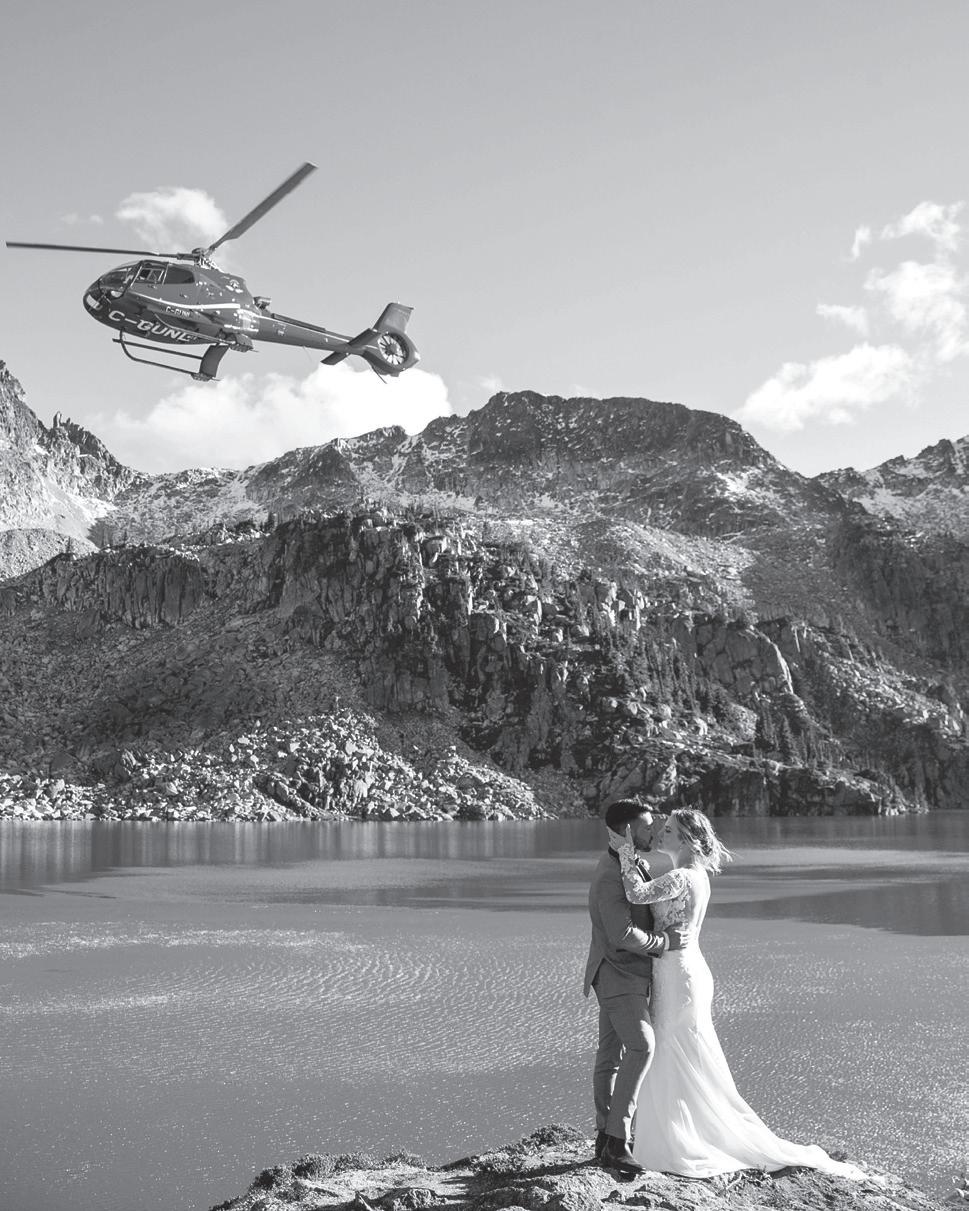

We have a rare opportunity to work at one of Canada’s best-read online newsmedia companies, Glacier Media.
You will be part of the Pique Newsmagazine team, a division of Glacier Media. In your role you will consult with local businesses to offer cutting edge marketing solutions: programmatic, social media, SEO, sponsored content and community display advertising on our website and yes, we still reach customers through our trusted newspaper as well.
• You are comfortable making cold calls and setting up/leading meetings with new and existing clients.
• A self-starter with a consultative selling approach working with clients planning both digital and print advertising campaigns.

• Building and maintaining client relationships with your exceptional communication skills comes easy to you.
• You are a goal orientated individual with a positive attitude and a willingness to learn.
• You possess strong organizational skills and have the ability to multitask in a fast-paced environment.
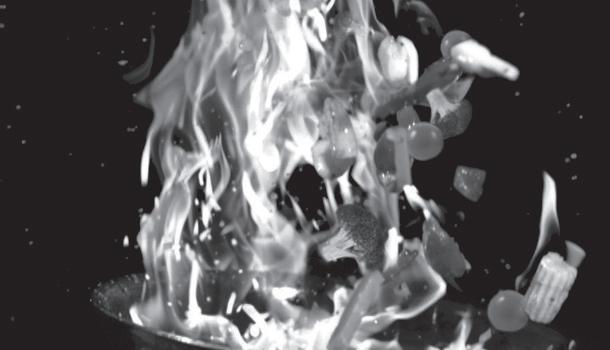

• Competitive salary + uncapped commission package.
• Comprehensive / competitive group health and welfare benefits


• Extensive onboarding training and ongoing support.
Whistler has a worldwide reputation for outdoor recreation and boasts a vibrant village featuring restaurants, bars, retail and more. While this legendary resort is an international mountain sports mecca, it is also a down-to-earth mountain town, where community and culture have forged a unique environment. This opportunity offers you the chance to call a world-class ski hill you own—and if you are a local, well you know you’re in the right place to forge a career and lucky to call Whistler your home.
To apply, please submit your cover letter and resume in confidence to Susan Hutchinson, shutchinson@wplpmedia.com
Closing date: Open until filled.
At the Liquor Distribution Branch (LDB) our vision of ‘Service. Relationships. Results.’ is all about providing a valued service, building strong relationships with our stakeholders, and achieving greater results for the province.
The LDB is one of two branches of government responsible for the cannabis and liquor industry of B.C. We operate the wholesale distribution of beverage alcohol within the province, as well as the household retail brand of BC Liquor Stores.

We employ nearly 5,000 people in over 200 communities and have been named one of BC’s Top Employers 14 times over for offering exceptional places to work rooted in values of fairness and respect, work-life balance, and inclusion and diversity. We believe that our people are our greatest asset. Being a reputable employer with programs of skills training and professional development are what attract candidates to BC Liquor Stores, while our progressive, forward-thinking culture is why employees with a growth mindset thrive.
Auxiliary positions are on-call, meaning hours of work are not guaranteed and subject to availability. Some auxiliary employees may not initially work a full 35-hour week, but with more hours worked and more seniority gained, more opportunities for more hours of work will follow.
Auxiliary positions are not permanent full-time but can lead to permanent full-time opportunities with a very competitive total compensation package, including a comprehensive pension plan, medical and dental coverage (including massage and physiotherapy), tuition reimbursement and scholarship programs, and access to public service employee benefits including career support services, financial and legal services, and employee and family counselling.
We are dedicated to the highest quality of customer service, delivered with friendliness, individual pride, initiative, and retail passion! If you fit this description and you are prepared to work in a fast-paced environment, we encourage you to apply to become a part of the Whistler area BC Liquor Stores.
To be eligible, applicants must meet the following qualification requirements:
• Be at least 19 years of age
• Be able to legally work in Canada
• Be able to provide excellent customer service


• Be able to communicate effectively and professionally with the public


• Be able to demonstrate aptitude for cashier and related duties, including calculations
• Be able to perform physically demanding work, including lifting 20-25 kg boxes
• Have a valid Serving It Right Certificate™
• A Criminal Record Check is required.
BC Liquor Store Sales Associates may be required to operate a variety of mechanical and hand-operated equipment, in addition to handling large volumes of bottles as part of the LDB’s recycling program.

Rate of Pay as of April 10, 2022: Auxiliary Sales Associate - $20.33 per hour Seasonal Sales Associate - $18.92 per hour

For exciting and challenging retail opportunities, please apply online at:
On November 1, 2021 the BC Public Service announced the COVID-19 Vaccination Policy that defines the conditions and expectations for BC Public Service employees regarding vaccination against COVID-19. Among other possible measures, proof of vaccination will be required. It is a term of acceptance of employment that you agree to comply with all vaccination requirements that apply to the public service. More information can be found here: https://www2.gov.bc.ca/ gov/content/careers-myhr/all-employees/safety-health-well-being/health/covid-19/covid-19vaccination-policy-for-bc-public-service-employees









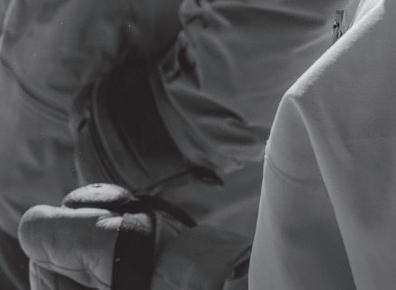

The Senior Manager, Content Marketing is responsible for developing content and stories to communicate the Whistler brand through Tourism Whistler’s social, web, blog, and app channels. This position oversees the development and maintenance of the marketing content calendar, ensuring all Whistler experiences and events are communicated to the right audience at the right time, and collaborates with internal teams to enhance the website’s user experience.



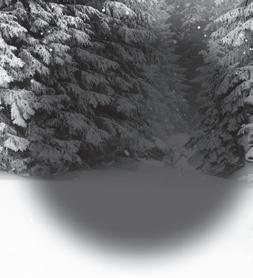






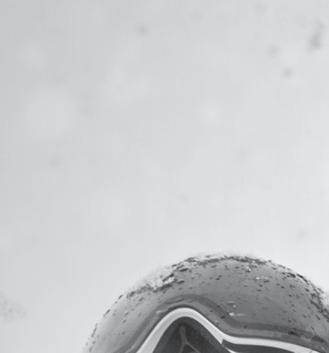

The Senior Manager, Content Marketing is a strategic thinker, exceptional leader and strong communicator. With experience developing content marketing programs, and knowledge of web and social platforms, this position requires effective planning and execution skills, with the ability to positively engage and motivate various stakeholders.




























Stopped a squeak
Ga. neighbor
Rustic abode
Kansas City player
Elegant coiffures
Chopin piece
Like a monarch
Travels on snow
Gave out sparingly
Nose stimuli
Lowdown
Sur ng the web
Orbit extreme
Beluga product
Wool growers
Overhead trains
Herr’s residence
Excellence
Noted quilt makers
Kemo Sabe’s friend
“As -- --” (usually)
More boorish
Hobby knife (hyph.)
Inbox ller
Responsibilities
Picasso or Neruda
Caught cold
Talks up
Glamorous
Type of puzzle

Folks
Mr. Spock’s father
Piano piece for two
Unfroze
Ran at an easy gait

Biscotto avor
Mineral deposit
Come to an end
Sense organ
Expectant dad, perhaps
Banded quartz
Remove listening devices
German white wine
Tornado nder
Go -- (cooperate)

Moisten with drippings
Tampa Bay gridders, in headlines
Needing rain
Type of luck
-- Lupino
Less than one
Spanish gold
Tasty legume
Harvest moon mo.
Hand-dyes with wax
Get nosy
Target practice area
purples
Debit’s opposite
Taking advantage of
Friar’s title
Really nice person
Adores
Uniforms
Charles Lamb
Famous canal
“Cool!” (2 wds.)
I-70
Hold the oor
Cunning ways 20 Puts the nger on
Yearns for 33 Puget Sound port
Realty units


Complain
Public Citizen founder
When to see stars
Plaid items
DeMille movies
Elephant gone amok
Brainy club
WELL, WELL, WELL, ‘tis the season to be jolly. In keeping with my dearly-departed mother’s admonition about not saying anything about someone or something if I can’t say something nice, and in honour of the season of excess, I’ll simply turn my attention to sorting through my email inbox and running
another episode of Tales From the Inbox. At least that way if something not so nice slips in, it’s on the correspondent, not me. Ho, ho, ho.
Dear Max: What the f@%k is up with Vail Resorts? Have all the groomers quit? I was really looking forward to getting some good turns in before the holiday rush but there’s almost nothing groomed. It’s not like there’s so much open terrain they couldn’t manage to groom another run or two, which it seems would almost double what they’re doing now. I mean, how is it safe to only have one or two groomers crowded with ski school groups and people?
BY G.D. MAXWELL GETTY IMAGES - Tired of RerunsDear Tired: In keeping with the spirit of the holidays, let me see if I can put a more positive spin on your observations.
I fear you go overboard just a bit. Understandable, but really, I’m sure not all the groomers have quit. I see lights on the mountains at night and I see a couple of groomed runs every day when I go up. True, they’re the same ones, and they might be crowded, but they are groomed. Maybe this is Vail’s effort to instil a sense of nostalgia among old-timers. There are still people around who fondly remember the early days of Whistler when there was no grooming. Perhaps we’ve all just gotten soft, and this is Vail’s attempt to put us in touch with our roots.
Or you could put a positive, environmental spin on it. Doing so little grooming may be part of Vail’s Epic Promise, and good intentions to operate at net-zero some time in the future. After all, those big machines use a lot of fuel just to make sliding around easier.

As for safety, Vail has identified “uncompromising safety” as a core value of the company. It says so right on the Whistler Blackcomb webpage. Please don’t tell me you’re suggesting they’re just blowing smoke about such an important issue. Heaven forbid.
In short, let’s be a little more understanding and charitable for the holidays. There’ll be plenty of time in the new year to complain about Vail’s failures.
Hey Buddy: My mind was blown when I read the RMOW is going to hit us with a property tax increase over eight freaking per cent. Not sure how that’s going to help the overall rate of inflation that keeps making the price of everything more expensive and it sure isn’t
going to help make Whistler more affordable. I know in the past you’ve been pretty outspoken about things like this. What do you think?
- Perplexed and P$%&ed-Off Property Owner
Dear Perplexed: As with Tired, I’ve taken the liberty of cleaning up your moniker. This is,
home is going up by more than 10 per cent. Eight seems like a bargain by comparison.
Surely you can’t think there’s waste in the municipal budget. Ouch! Sorry, tongue stuck painfully in cheek. But feel free to comment directly to either budget@whistler.ca or finance@whistler.ca. I’m sure they’d love to
As for the leader of the official opposition, I’ll admit I’ve never been very good at explaining the context of weird connections that happen in my head but never make it into print. And, in retrospect, I can see how PeePee might conjure up disconcerting urinary oopsies. But in my mind, Mr. Poilievre reminds me a lot of Pee Wee Herman, and his initials are P.P. He seems about as clued in as Pee Wee was before that tragic incident in a Sarasota theatre, and bears at least a passing resemblance. So I take your criticism to heart and will, henceforth, ensure there’s a space between Pee and Pee when I refer to him thusly.

after all, a family newsmagazine.
At the risk of veering too far from my selfimposed holiday spirit, I’ll just say I too was a bit shocked at the proposed increase. But who am I to not believe the mayor when he says he has to raise taxes that much to keep pace with rapidly rising inflation, keep municipal services at current levels and attract and retain employees? It’s not his fault if your property value is slipping. Not his fault your pay isn’t going up as much as muni workers. Certainly not his fault you feel hosed every time you buy groceries.
If you’re over 55, you can defer your property taxes, unless your Whistler home isn’t your principal residence, in which case quit complaining. And really, what’s another $100 for each million your home is worth?
I mean, the cost of insurance on my small, inexpensive Whistler Housing Authority
hear from you.
Max: I think you hit a new low recently referring to the leader of the official opposition as PeePee and the premier of Alberta as a looney. You’re better than that.
Dear Disappointed: Sorry to disappoint you again, but no, I’m not.
Let’s take the easiest case first. Danielle Smith is a looney. Whether it’s her cockamamie Alberta Sovereignty Within a United Canada Act, which it seems she, like other members of her caucus, hadn’t actually read until called out on its antidemocratic features, or her now-infamous claim moderate cigarette consumption is actually good for your health, Ms. Smith has justifiably earned the sobriquet. QED.
Max: Do you know when there might be a ski-out to Creekside? I’d rather park there and take the shuttle until they get the new gondy running, but shuttling at the end of the day is unpleasant.
- BussedDear Bussed: No idea. But again, think of all the emissions Vail is saving by encouraging people to leave their cars at Creekside and bus to the village. Epic.
That’s it for now. Except to say—and it has nothing to do with my inbox—there will be a “dramatic” reading of Charles Dickens’ A Christmas Carol next Thursday, Dec. 15 at 7 p.m. at the Whistler Public Library. It’s free. You know the story, children are welcome and you’ll be home in time for a nightcap. If that isn’t enough, the readers include well-known locals and Mayor Jack is turning a star role as Scrooge. I swear no typecasting was involved. Email publicservices@ whistlerlibrary.ca to sign up so we know how many of you are coming. ■
[T]hink of all the emissions Vail is saving by encouraging people to leave their cars at Creekside and bus to the village. Epic.
Rob Boyd 604-935-9172








Whistler
